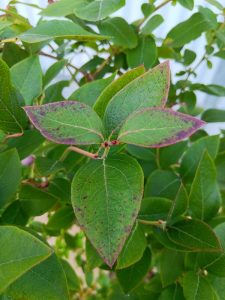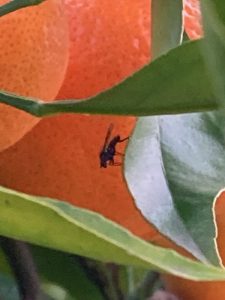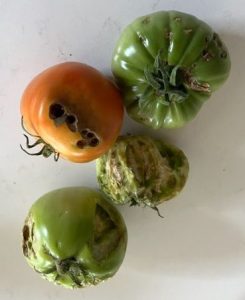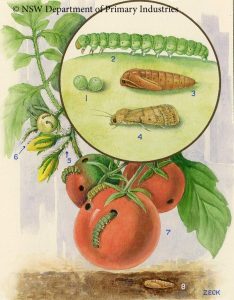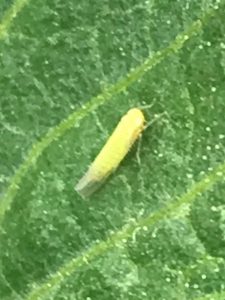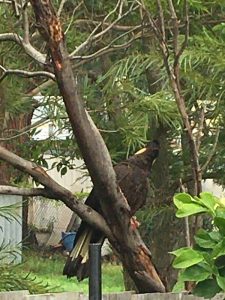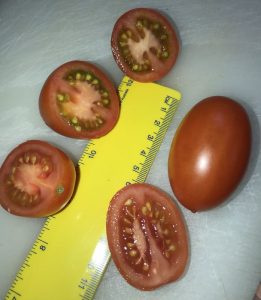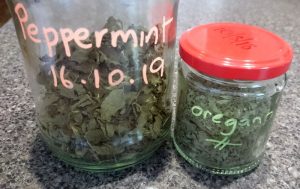Do you know?
Question |
Answer |
|
|
Amy Aednat Ciara: Your blueberries are showing signs of trace mineral deficiency (e.g. iron, manganese, etc). I would hazard a guess from where it is yellowing, and the necrotic spots occurring, that the soil is too alkaline. But best practice is to get a pH kit and to test the soil according to package instructions. [Editor: unlike most plants, blueberry plants need an acidic soil to thrive, preferring a soil pH of 4-5.] Tips with the standard pH liquid and powder kit. Really shake the powder very well! Big clumps make it harder to judge the colour. Make sure that the liquid solution turns the soil sample into a pasty mud-like consistency. Add soil if too wet and watery or more solution if too dry. Finally the pH scale is to the power of 10 so there is a 10x difference between the numbers. For example a pH of 5 where 7 might be needed, means the soil is 100 times too acidic! Also the final colour of the sample is best viewed in natural light. A short term solution to Meg’s problem would be to add sulphur if too alkaline or lime if too acidic, and follow package instructions carefully. Longer term, Meg can try adding more acidic or alkaline compost, compost teas or organic matter. Meg could also plant a plant that raises pH in the soil near it (e.g. a eucalypt), if it is too alkaline. Sometimes too much water and poor drainage creates an increased alkalinity too. |
|
91. Judith Cooke: We have black aphids attacking our garlic and spring onions in our community garden in West Brunswick. We have hosed and sprayed with white oil to no avail. Any organic suggestions? |
Angelo Eliades: Black aphids on onion family plants can be difficult to get rid of if pest controls aren’t used correctly. Aphids breed very quickly and can produce offspring every few days, so the schedule for spraying horticultural oil (such as Eco Oil) needs to be quite frequent to break their breeding cycle. For aphids, apply two sprays, 3-5 days apart, preferably 3 days apart in this case, and repeat up to 3 sprays over a 4-8 week period. The application rate of horticultural oil for aphids is approximately 5ml/litre of water. To increase the effectiveness of this controls, hose off the plants the next day after spraying using a moderate pressure jet of water that’s strong enough to blast the pests away while not damaging the plants. The combination of these controls used over a 9 day period should eliminate any aphid problem. Pam Jenkins: I used white oil a couple of times with little success. I then added in drenching the plants in used washing up water daily for a few days between sprays. No sign of the aphids now. Pauline Webb: I gave my garlic chives with black aphids a dose of Seasol last week to (surprisingly) find none a few days later. I had done similar a couple of months earlier to no avail. Good timing? Luck? Richard Kottek: I have sadly found out over the years that, once a garden or site has been infected, that is the end of the story with growing alliums. The only thing I have found is to grow alternatives such as European wild garlic (an edible garlic flavoured herb), society garlic, asafoetida or (as an onion alternative) onion weed. |
|
90. Jennie Ramage: What should I top dress my garlic with? |
Angelo Eliades: With top-dressing, the idea is that, as a top-up feed, you sprinkle a small amount of the same fertiliser that was originally used in the main feed, and then water it in. With garlic, this would mean adding some more of the same fertiliser that you used when you planted the garlic. Top-dressing is a traditional practice but, in my opinion, is not a sound practice these days. Fertilisers need to be incorporated (mixed) into the soil so that the soil organisms can break them down and slowly release the nutrients in a form available to the plants. If fertilisers are left on the soil surface then the nitrogen in the fertiliser will volatise into the atmosphere and be lost. Furthermore, only highly soluble, and therefore very fast acting, synthetic chemical fertilisers can be sprinkled and watered in, and organic gardeners don’t use such fertilisers. If they are used, plants are force-fed while taking up water and, if used on garlic at the late stages of development, the high levels of soluble nitrogen will promote (force) green growth at the expense of bulbs, resulting in lots of garlic leaves at the top, and disappointingly small bulbs below the soil. Rather, if you want to do something, my suggestion is that you either lightly dig in some organic fertiliser into the soil or place it under the mulch (if such mulch exists). |
|
89. Vicki Jordan: I am considering putting a wire fence around it. What hole size will allow bees and other pollinators in but keep rats out? |
Douglas Bell: After a lot of trial and error, the only way that I have succeeded in keeping out rats is to have a structure fully enclosed in aviary mesh with an aperture size of 12½ by 12.5½mm (see photo right). The bees pass through it easily. I use mesh where the wires are 0.7mm in diameter because the 1.24 mm thickness mesh is much harder to work with, more expensive and (in my garden) unnecessary. I dig a 10-12 cm trench around the border and set the mesh in the bottom of it, curved outwards to stop rats and rabbits burrowing underneath. Angelo Eliades: Generally, rats can squeeze through any gap or hole that is larger than their head, and a rat’s skull is around 15-20mm in width, so they can fit through surprisingly small openings around 20-25mm in diameter or wider. The mesh size of any wire has to be smaller than that to keep them out. |
|
|
Museums Victoria: the photo is not of sufficient quality for the insect to be identified. Kerry Wise: definitely a good guy. Maybe a soldier fly (whose larvae are super composters). Effie Bridge: it is a good guy. Pam Jenkins: It looks like a fly from the Anthomyiidae family. Its maggots grow in decomposing animal carcases. Neither a good guy nor a bad guy. |
|
87. Celesta Van der Paal: How to dry large chillies? |
Susan Palmer: Depending on my mood and how many chillies I have, I either use a dehydrator or freeze them. When dehydrating larger chillies, I make a single lengthwise cut to help the drying process. Olwyn Smiley: I puree them with oil and freeze in small containers. So easy when a dish calls for chilli. Taking it out of the freezer at the start of the meal preparation means it has thawed just enough to chisel out as much as is needed. I make up and freeze harissa in the same way. Lynn Wallace: Collect the fruit as it ripens and freeze. When enough fruit has been gathered or when the season is over, de-frost, blitz with some coarse salt and good quality fresh oil, and pour into sterilised jars (5 minutes in a microwave with a slurp of water). Keeps for years in the fridge. Taste test before use because it can be very concentrated and might blow your head off. |
|
86. Anon: There are only two of us (small eaters, with not a lot of waste) and our green cone bio-digester seems to be getting higher and there are odors are times. It looks like the rats have had a dig but didn’t get in. The ground around it is pretty hard and dry and the contents also seem to be pretty dry. I’ve seen activators but they are from UK and expensive. Does anyone have any DIY activator ideas? Should I add some water or what else should I do? |
Kat Greenham: I add some bokashi mix/activator and that has been helping. Karen Olsen: There is a simple metal spiral stake with a screw on the bottom that you can buy from most places – inexpensive and effective. Lucinda Flynn: I use a green cone and it is phenomenal; I have had it for years and it just keeps going with no need to empty it. It sounds as if the contents and soil around are just too dry. Every time I water the garden, I also water the compost. It should be really moist to allow micro-organisms to grow and attract worms into it. Pauline Webb: I have had a green cone bio-digester for around 5 years, since Manningham Council promoted them – installed it 4-5 years ago. It came with a sachet of starter powder – probably of mycorrhizal origin. Mine is never dry, worms abound, the volume drops readily after every feeding of excess food scraps, weeds and excess veggie material not suitable for mulching. My suggestion for activation it to re-start it with mycorrhiza (Neutrog Popul8 liquid or Munash mycorrhiza powder) and watered. Note that if the digester is buried into clay soil, that can apparently be an issue. James Petty: To activate the bio-digester, add a shovel of well-rotted compost (which will add bacteria, fungi etc). Some other suggestions/notes:
Angelo Eliades: If the ground around the bio-digester is pretty hard and dry and the contents also seem to be pretty dry, then it’s not going to work at all. Adding activators won’t do much either. Soil micro-organisms require a warm, moist, dark environment filled with organic matter to feed on. The ideal moisture content for any composting material is that of a kitchen sponge squeezed out in a single hand, the moisture content should be felt, and a drop of water should be able to be squeezed out of the material. Add water to maintain sufficient moisture levels to encourage microbial decomposition. Additionally, the more the material in the bio-digester is cut up into smaller pieces, the more surface area is exposed for the micro-organisms to act on. Note that it’s simple to make your own compost activators, and the herbs comfrey, nettles and yarrow well work well for this purpose. I (Angelo) have written a detailed article on this subject on my website. |
|
85. Claire Stronge: I struggle with sourcing wood suitable for large garden structures/wigwams to grow sweet peas and climbers. In the UK, I always made them with flexible hazel foraged in our local woods. I’d love to stop using bought bamboo canes but I’m not sure what locals use here. Any advice? |
Janet King: bamboo canes. Claire can have some from my black bamboo clump. Olwyn Smiley: bamboo canes. I use bamboo canes cut from the rampant running bamboo that has strayed under neighbours’ back fences into the ‘right of way’ adjoining the bike track behind my house. James Petty: fig branches. A winter prune of a mature fig tree should give you plenty. They are not flexible like hazel but they are sturdy. Note that the branches may root at the cut end if submerged in soil. Virginia Solomon: hazel canes. I have hazelnut trees and would love to trade know-how for canes. I have 4 trees – they probably need a good thinning but I don’t know how to split and prepare them. I never get any nuts because they are all the same variety, but I too would love to use my own hazel canes instead of shop bought bamboo. Paul Gale-Baker: mulberry branches. If you know someone with a mulberry tree which throws up tall vertical branches – watershoots – ask them for some after they’ve pruned. They are frequently very long and with enough flexibility to be used for structures – and there are usually plenty of them. I have them in profusion after fruiting on my mulberry. Claire Smith: Join your local Buy Nothing group and ask if anyone is giving away garden stakes or is growing bamboo and is happy to have some canes cut down. Your local community Facebook pages could also be a source of garden stakes and the like. |
|
|
James Petty and Pam Jenkins agree that the culprit is the native poroporo fruit borer (Leucinodes cordalis), whose larvae eat vegetable plants in the capscium and solanum genera. |
|
|
|
|
82. Kristine Hendley: Has anyone had experience in growing fruit trees in rocky areas? I have re-located to Maiden Gully and my block is very rocky. It has been suggested that I either dig out around 1½ metres of rock and fill it with dirt or else build up over the rock in raised garden beds. Alternatively, has anyone one had experience growing fruit trees in wicking beds? |
Guy Palmer: This is a common problem for many of us. I dig a large hole (using a mattock if necessary), at least twice the diameter of the root ball, and fill it with a mixture of potting mix and the original clay soil/rock. Near the centre of the hole is pure potting mix, with the proportion that is clay soil/rock then increasing as one moves away from the centre. The idea is to avoid any sort of discontinuity of soil composition which would then act as a barrier for the roots. Kayte Kitchen: I have had a fair bit of success growing fruit trees in IBC wicking beds in various versions. All dwarf trees but a full range. We grow all of our produce in IBCs now as we have large eucalyptus trees and clay soil that affected our in-ground gardens. You are welcome to come and have a look anytime, I live in Greensborough. |
|
81. Nerida Kirov: Where can I buy some collard greens (aka colewart) seeds? They are a cultivar of Brassica oleracea. |
Anna Hetyey: The Seed Collection for georgia southern collards or Seeds of Plenty for morris heading collards. Note that Seeds of Plenty are local, being based in Eltham. |
|
80. Jo Buckle: I was worried that my soil / compost would be too acidic as my compost contains large quantities of coffee. Sometimes I mix the coffee grounds in with other compost materials and sometimes (if I have too much of it) I separate out the coffee grounds, add sawdust and let the worms do their thing. I was surprised that my compost was so alkaline. Is this a problem? The composted coffee seems to lose its acidity over time (and the worms like it). There might be other problems with so many coffee grounds in finished compost apart from pH levels – not sure whether caffeine or other components will be a problem. One thing is that it’s not very free-flowing and it tends to form sticky mud when wet. |
Marina Bistrin: Re the alkalinity of compost, it is surprising that some compost is so alkaline; however, once spread and mixed with other soil, that may all even out (same with acidic compost). Re the stickiness of composted coffee, I use a well mixed layer of coffee grounds, coffee husks, sawdust and sand throughout my compost. I have occasional batches of aged compost that are sticky and mostly worm castings. I think mixing in mulched garden material as a layer may give it some bulk and air in the finished product. Also, if it is too sticky, what about mixing with water and using it as a liquid fertiliser? |
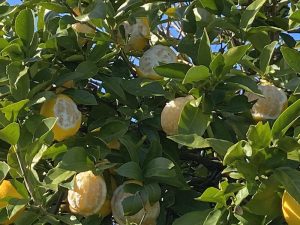 79. Jeremy Mather: What is eating the rind of the lemons on my tree? Possums? Cockatoos? Can anybody suggest some deterrent or otherwise to protect my crop? 79. Jeremy Mather: What is eating the rind of the lemons on my tree? Possums? Cockatoos? Can anybody suggest some deterrent or otherwise to protect my crop? |
Angelo Eliades: Possums. Cockatoos don’t eat the peel, but the seeds inside. Rats wouldn’t have eaten that much peel. Protect the fruit with nets, either netting bags (2mm mesh drawstring bags that go around the fruit) or just net the tree. Carol Woolcock: Snails. They hide under the leaves during the day and come out at night to feast. The best remedy is to inspect the tree and remove the snails on a daily basis until the problem is resolved. Pauline Webb: Maybe possums but I would suspect rats. My lemons are similar and they then fall to the ground when a bite is taken from the skinless fruit. By contrast, my mandarins are eaten out (fruit only) leaving withering skins on the tree. Roger Warr: Maybe rats or mice. We have them and they do similar damage, although ours also eat the flesh. [Editor: FWIIW, I agree with Angelo: the most likely culprit when the citrus rind has been eaten but not the insides is possums.] |
 78. Jan Connor: Can anyone identify what has happened with my current crop of cumquats (see the two pictures right)? About half of them are oddly misshaped, and their flesh is shrunken and light to dark brown in colour. 78. Jan Connor: Can anyone identify what has happened with my current crop of cumquats (see the two pictures right)? About half of them are oddly misshaped, and their flesh is shrunken and light to dark brown in colour. |
Angelo Eliades: That cumquat problem is clearly a sign of nutrient imbalance/deficiency. More specifically, it is excess nitrogen combined with low phosphorus, which will cause citrus fruit to be misshapen, with thick peel, a coarse and roughly textured rind, coarse pulpy flesh without much juice, and an open centre. The juice will also be more acid in these fruit. Read my article about these problems. |
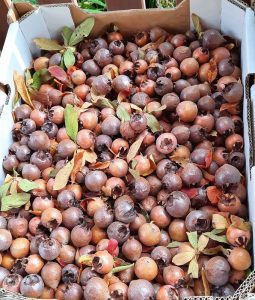 77. Liz Cronin: We (Warrandyte Food Swap) have been given a lot of medlars to give away. We would like to provide some advice to people on what to do with the medlars, including some recipes, but they don’t know enough to do this. 77. Liz Cronin: We (Warrandyte Food Swap) have been given a lot of medlars to give away. We would like to provide some advice to people on what to do with the medlars, including some recipes, but they don’t know enough to do this. |
Alison Raven: In the past we have made medlar jelly and medlar ‘cheese’ (a paste really, that I have used in cake baking). They are pretty fiddly to prepare, because of the seeds, so it’s not surprising they went out of favour in this age of fast and easy food prep – they are definitely a ’slow food’! Here are some recipes: medlar cheese, medlar tart and medlar jelly. Anna Matilda (aka Urban Nanna): I have written a comprehensive article about medlars last year, including details on bletting, ideas on how to use them once ready, and links to a couple of recipes. Emma Duncan: Don’t transport them when they’re really ripe as they can explode with the slightest pressure! |
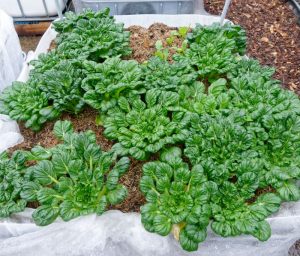 76. Guy Palmer: On recent a visit to Oakhill Farm, I saw a veggie growing in their veggie patch that I had never seen before. I thought it looked both unusual and rather attractive. My Google friend suggests that it is tatsoi (Brassica rapa subsp. narinosa). Any tips on how to grow? 76. Guy Palmer: On recent a visit to Oakhill Farm, I saw a veggie growing in their veggie patch that I had never seen before. I thought it looked both unusual and rather attractive. My Google friend suggests that it is tatsoi (Brassica rapa subsp. narinosa). Any tips on how to grow? |
Everyone confirmed that the photo is tatsoi. Nancy Mills: My latest tatsoi is self-sown – who doesn’t love a volunteer – and is much bigger than any I’ve deliberately planted. It appeared in a tomato pot during white cabbage butterfly season, withstood major attacks, and is now powering ahead. From my modest experience, I suggest planting tatsoi in early autumn and netting it during cabbage butterfly season – like other brassicas. It responds well to liquid fertiliser every two or three weeks. Bruno Tigani: Often tatsoi is grown at high density for baby leaf production, similar to how you grow baby spinach. It’s very easy to grow, year round from seed, direct sown. It’s fast to mature. Emma Duncan: Grow like pak choy: cover to protect from white cabbage butterfly, full sun, well drained soil, water regularly. You can pick individual leaves from the outside. Use in salads. Ann Stanley: Tatsoi tastes good and is nutritious. It is easy to grow straight into the ground from either seed or seedling. Choon yin Yeok: You can buy tatsoi seedlings at many nurseries. They look good in my veggie patch. I stir fry them. Lynette Mackenzie: I’m the volunteer looking after the veggies at Oakhill Farm. The keys to growing tatsoi are good soil, sunshine and water. |
| 75. Tereza Ash: My understanding is that tree collards should be grown from cutting rather than seed. But I don’t know anyone who she can get a cutting from, not do any of my local nurseries sell them. Do you have a tree collard that she could potentially have a cutting from, or know someone who does, or know of a nursery who sells them? |
Guy Palmer: Tree collards are a perennial brassica, producing blue-green or purple leaves which taste similar to kale. They grow up to 3 metres in height but can be kept much smaller. They are in the same Acephala group of Brassica oleracea as kale. Daleys sometimes sell them online but are currently out of stock. Read more on the Project Tree Collard website. The key point is, of course, that tree collards are perennial (as opposed to biennial or annual). Other edible, perennial brassicas are apparently kosmic kale and jersey cabbage. Angelo Eliades: I tried to grow tree collards around a decade ago in a propagation project in Brunswick with the guys from VEG. The plant grew strongly to around two metres tall but then succumbed quickly to pests and diseases as the weather cooled down. I have never met anyone who has successfully grown this plant for longer than a year in Victoria. Maybe our conditions just don’t suit it. |
| 74. Louise Nolan: For the last few years my veggie garden has been experiencing fungal disease regardless of crop rotation, adequate spacing and watering only the base. All my beds are mulched with pea straw which is topped up as needed. I believe that the initial culprit was a bale of pea straw that was black and grey throughout. There is rust on my fuchsia and geranium, black spot on my peas and beans, anthracnose on my cucurbits, blight on the my tomatoes and powdery mildew on my zucchini and pumpkin. My apple tree also had a disease which looked like a blight. I also had a terrible whitefly infestation, which has now died down with the summer heat. I regularly water with a seaweed liquid and a fish emulsion as required. I have used Neem oil and also resorted to a copper spray for the diseases. The soil pH is neutral, the garden gets morning north sun but is hot in the afternoons with the west sun. I’m at my wits end on how to get on top of it all. | Olwyn Smiley: As I understand it, fungal diseases are specific to particular plant types so, whilst fungus in pea straw may affect pea plants, it is unlikely to cause the range of fungal diseases described by Louise. However, warm, humid weather is perfect for just about every type of fungal organism, and we have had weeks of warm, humid weather! It also seems to have been a bumper season for white fly (Trialeurodes vaporariorum or Bemisia tabaci species probably) and passion vine hopper (Scolypopa australis). |
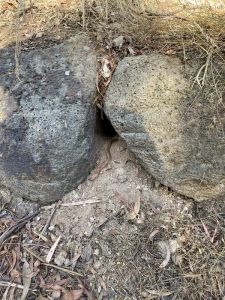 73. Sarah Houseman: I have an established native garden and we have a big problem this year with rats using our rockeries as highways and homes. They show their activity by leaving piles of excavated soil and they are destabilising plant roots. As we walk over the garden, our feet subside. Does anyone know of any ecologically friendly method of dealing with rat infestations? 73. Sarah Houseman: I have an established native garden and we have a big problem this year with rats using our rockeries as highways and homes. They show their activity by leaving piles of excavated soil and they are destabilising plant roots. As we walk over the garden, our feet subside. Does anyone know of any ecologically friendly method of dealing with rat infestations? |
Olwyn Smiley: I have tried just about every trap, deterrent and also poison. The latter is a last resort, but what else can one do if rats are in the ceiling? Rats have eaten the bait from multiple varieties of snap traps and left them un-snapped (a snap trap in one of those black ‘wildlife-safe’ boxes also unfortunately caught a blue-tongue lizard); an expensive ‘nooski’ trap failed utterly but is not a bad receptacle for wildlife-safe bait; and expensive and complex cage traps have been unsuccessful. The best solution for me has been a simple cage trap that a friend found on hard rubbish (see photo right). If using poisons then, according to Birdlife Australia, the chemicals which do not affect wildlife should they eat a poisoned rat are Warfarin and Coumatetralyl. Karen Olsen: Get a terrier or other ‘ratter’ dog. Don’t get a cat as they will often go for native fauna species first. Kookaburras also deal with a lot of our rats (but not all), so please don’t use poisons on rats as they are a common food source. The supposedly eco-‘friendly’ rat poisons appear to only have a little less toxicity, so large predator birds will just take longer to build up the same levels of toxicity in their systems from poisoned food sources. Delldint Fleming: The best poison for rats is Racumin as it does not cause secondary poisoning in other creatures such as owls, reptiles, chooks, etc. Whilst it is expensive, I think that it is worth it to be responsible in the ecosystem. It’s the only poison recommended by my friend George Paras of the Warringal Conservation Society, who used to care for the wildlife reserve at Latrobe Uni. |
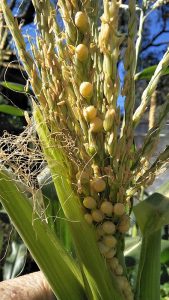 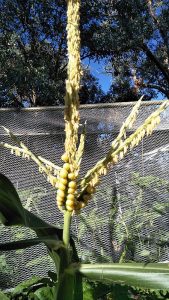 72. Kerry Bradford: How come there are a few (female) kernels growing in the (male) tassels of my sweetcorn? 72. Kerry Bradford: How come there are a few (female) kernels growing in the (male) tassels of my sweetcorn? |
Bruno Tigani: this phenomenon is something called ‘tassel ears’. As most of you will know, sweetcorn has separate male and female flowers, with the male (called a ‘tassel’) at the top of the plant and the females (called ‘ears’) lower down the plant. As most of you probably don’t know, however, both types of flower start of as being bisexual, with one sex then being aborted early on. Sometimes environmental triggers, such as soil compaction or wet soil, can apparently lead to hormonal changes which stop the abortion happening. Then some kernels can develop on the tassel. Google ‘”tassel ears” corn’ and you will find a number of articles on the subject, including this article. There is even a video. |
| 71. Vicki Jordan: Why are my beans flowering but not fruiting? |
James Petty: They may be getting overheated. Runner beans like good sun but don’t like getting too hot. I once tried growing them on a trellis against a brick wall that absorbed a lot of heat: lots of flowers but no fruit. Maria Ciavarella: Too hot and bean fruit might not set. The ideal temperature range is 24-30degC. Note that the presence/absence of bees is not relevant because bean flowers pollinate themselves. Pam Jenkins: Climbing beans prefer temperatures below 29degC. They will fruit when the weather cools a bit. There are two other possible problems. 1. Not enough sunlight: bean plants need around 7 hours of sunlight to produce beans. 2. Not enough water: beans are thirsty plants and quickly react to a lack of it by dropping their blossom. |
| 70. Lucinda Flynn: Where do all the Italians go to buy their bulk passata tomatoes in the Thornbury, Coburg and Brunswick areas? |
Dan Wilson: Psarakos Market, 2/8 Clarendon Street, Thornbury. Penny Smith: Psarakos Market, 2/8 Clarendon Street, Thornbury. Susie Lightfoot: Preston Market. Yennie Starkey: Preston Market. Victoria Johnson: corner of St Georges Road and Oakover Road, Preston. Anna Buzzelli: Gervasi Foodworks, 870-872 Sydney Road, Brunswick. Also, Mediterranean Brunswick, 482 Sydney Road, Brunswick. Lesley Shuttleworth: on Gaffney Street, near the intersection with Sydney Road, Coburg North. Irina Zahra: Morabito Wholesale Fruit & Vegetables Grocery Market, 169 Settlement Rd, Thomastown. Bruno Tigani: There is always a site westbound on Mahoneys Road in Thomastown, just before it goes underneath the Western Ring Road. When they have the tomatoes, it is well signed Steve Burnham: On the west side of Sydney Road in Fawkner, not much past where the tram line ends. Look for a sign pomodore per salsa. Maria Ciavarella: Thomastown, Lalor and Bulleen are all popular places to go where they’ll stock them but it is best to pre-order if you want more than one box at a time. Mardi Caracoglia: if Lucinda is willing to go a bit further out, corner of Metropolitan Ring Road and Sydney Road, Campbellfield; you can’t miss it with the sign and tomato crates out the front. |
 69. Alex Salmon: I spend time working in a communal garden space in Burwood. Over the last few years, sheep’s sorrel (Rumex acetosella) has taken over several of the wicking beds. I have sifted through the soil with fork and hands to about 15cm deep, removing all pieces of root, but anything that escapes her soon flourishes. Someone else sprayed with Roundup but the plants soon grew back. In desperation, I am thinking about removing all the soil and either putting it carefully through a sieve to remove any root material or completely replacing it. Can anyone suggest an easier solution? 69. Alex Salmon: I spend time working in a communal garden space in Burwood. Over the last few years, sheep’s sorrel (Rumex acetosella) has taken over several of the wicking beds. I have sifted through the soil with fork and hands to about 15cm deep, removing all pieces of root, but anything that escapes her soon flourishes. Someone else sprayed with Roundup but the plants soon grew back. In desperation, I am thinking about removing all the soil and either putting it carefully through a sieve to remove any root material or completely replacing it. Can anyone suggest an easier solution? |
Chris Newman: Sheep sorrel likes acid soils and, according to this article, adding lime and fertiliser will help control it. Cheryl Kearney: I have had a similar issue with sheep sorrel growing rampant. I am on very acidic soil which sheep sorrel apparently loves. I have managed to gradually reduce it by repeatedly applying lime or dolomite, especially around the edges of the garden bed. In other words, my suggestion is that you increase the pH of the soil in the wicking bed to slow the sorrel and make it more manageable. Note that I also use sheep sorrel as a lemon substitute as it adds a great tangy lemon flavour to fish and salads; however, I can never use it all as it is so prolific. Working with weeds: a practical guide to understanding, managing and using weeds by Kate Wall has some words on the subject – here is an excerpt: “Sheep sorrel, chicory, dandelions, plaintain, bindii and clover all favour slightly acid soils. Adjusting the pH with dolomite will give a competitive advantage to the lawn over the weeds. In the case of plaintain and sheep sorrel, allow them to decompose in situ and they will act to slowly raise the pH of the soil naturally. They do this by being an accumulator of calcium and phosphorous, both nutrients which are limited in the low fertility soils that weeds are commonly found in.“ Debbie Crosthwaite: I have been battling sheep sorrel for many years and I have now mostly eradicated it from my garden beds (both ornamental and vegetable). It likes an acidic, low in nitrogen, soil. I have had success by applying a fair amount of garden lime, then mulching heavily with cardboard or newspaper and then pea straw. This takes time and patience. I initially tried to dig the sheep sorrel up, however, it grew up back stronger and more vigorous! Yuki Cameron: It looks like the plants have gone to seed so there may be lots of seed in the soil that may be germinating each time the bed is cleared. Removing the plants and roots may not be enough to get rid of this problem. Maybe put a weed mat or black plastic down and plant strawberry and selected veggie seedlings in small holes in the weed mat/black plastic. Note that you would probably need a drip watering system in the bed to keep it moist enough. Marina Bistrin: Sheep sorrel is very persistent. If the soil is removed, sieved and put back, some of the seeds may still be in it as they are quite fine and I suspect that it may need to be done two years in a row. Also, until Alex decides on what permanent solution to adopt, I suggest that she weeds out any of the flowering seed heads as they emerge to stop further spread. I also suggest that she only grows quick growing crops (e.g. lettuce and radishes) in that area so that a weeding can be done in between crops. My approach for any problematic weed that sprouts from root fragments is to cover the area with cardboard and mulch followed by ongoing monitoring to remove any shoots that come up through the cardboard barrier. The root fragments sprout and exhaust their energy growing long shoots under the cardboard looking for a way to get to the light. Once the bulk of the root fragments have died off, and the bed is back in production, ongoing monthly monitoring for any shoots will eventually deal with the rest. For sheep sorrel, there may also be a seed bank in the soil and/or there may be seed coming in from nearby plants so it might be hard to eradicate completely. Note that the leaves are edible so any seedlings can be harvested and used in small quantities (they contain oxalic acid) in a salad – read this website. |
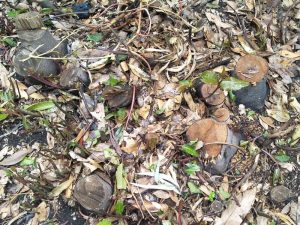 68. Meg Montague: I would appreciate some advice on how to control one bay tree and how to destroy the roots of another. I foolishly allowed both bay trees to get very tall, around 10 metres. 68. Meg Montague: I would appreciate some advice on how to control one bay tree and how to destroy the roots of another. I foolishly allowed both bay trees to get very tall, around 10 metres. 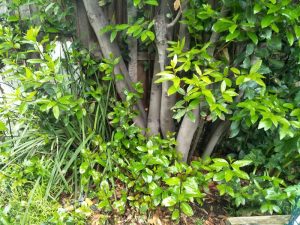 I have now cut one down but am having trouble destroying its roots and stopping it from suckering (see top photo). The other I am keeping but again it madly suckers and cutting these off only seems to encourage it to grow more (see bottom photo). What can I do to keep it under control? I have now cut one down but am having trouble destroying its roots and stopping it from suckering (see top photo). The other I am keeping but again it madly suckers and cutting these off only seems to encourage it to grow more (see bottom photo). What can I do to keep it under control? |
Angelo Eliades, re the one that keeps re-growing from the roots: The tree is trying to revive itself and you will need to kill the stump to stop that happening. Either did deeply around the stump and cut it out, or kill the stump using the Epsom salt technique, instructions here. Angelo Eliades, re the one that suckers: The best option is to cut the suckers below the soil line using a suitable tool for the purpose. As long as they’re not too thick or tough, the WOLF planting knife / weed extractor is ideal for the task, as the concave tip of the tool locates easily against the underground stem and cuts through with a sharp diagonal push. Jeanette Lynch, re the one that suckers: It’s best to attack them when they’re small and are easier to control. Spot spray with Slasher Organic Weedkiller to effectively kill the suckers but without harming the main tree, thoroughly spraying the sucker stem for the best results. Alternatively, suckers can be cut or pulled off the root or dug up. |
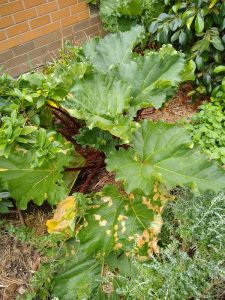 67. Pam Jenkins: My rhubarb is planted in an alkaline bed, even though I understand that it would prefer acid soil. It has been doing okay there for at least 10 years but every time I give it some plant food the leaves go blotchy like those in the photo. In the past, I have been feeding it with pellets of dynamic lifter or similar and thought that perhaps it was too strong and was burning the leaves. This time I fed it cow manure and ended up with the same result. Any ideas of what is happening? 67. Pam Jenkins: My rhubarb is planted in an alkaline bed, even though I understand that it would prefer acid soil. It has been doing okay there for at least 10 years but every time I give it some plant food the leaves go blotchy like those in the photo. In the past, I have been feeding it with pellets of dynamic lifter or similar and thought that perhaps it was too strong and was burning the leaves. This time I fed it cow manure and ended up with the same result. Any ideas of what is happening? |
Angelo Eliades: It looks like downy mildew, which affects rhubarb as well as cucumbers, squash, melons and spinach. If the light-brown patches start on the upper leaf surfaces, and grow in size until large patches of the leaf discolour, and eventually dry and fall out, then this is the problem. During wet mornings, the underside of the leaves will show a fine grey to purplish fungal growth. This fungal disease occurs during cold, wet conditions. Cut off the affected leaves and dispose of them (not in the compost), then spray the plant with a fungicide, such as eco-fungicide, to prevent it spreading. Bruno Tigani: This is likely a result of the cold, wet weather for extended periods, leading to higher fungal pressure. Read this article. |
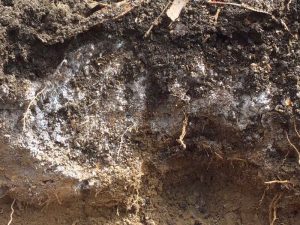 66. Nada Cunningham: When digging a hole for a new plant, or pulling out one that has recently died, I sometimes come across a layer of greyish, white cakey material. In the case of the recently dead plants, this material is encrusted around the roots. In the past, I have attributed it to being near large gum trees (of which I have many) or the application of uncomposted eucalyptus mulch. What is the cause of this problem and what are the possible solutions? 66. Nada Cunningham: When digging a hole for a new plant, or pulling out one that has recently died, I sometimes come across a layer of greyish, white cakey material. In the case of the recently dead plants, this material is encrusted around the roots. In the past, I have attributed it to being near large gum trees (of which I have many) or the application of uncomposted eucalyptus mulch. What is the cause of this problem and what are the possible solutions? |
Lynn Wallace: If looks like mycorrhizal fungi and, if so, that is a very good thing! This newsletter from Biostim explains the science. I have bought their product and applied it to the root system of seedlings etc as they were planted this spring, with the result that the plants have established and grown with noticeable vim and vigour. Lucky Nadia if she has mycorrhizal fungi occurring naturally!” [Editor: mycorrhizal fungi is a type of fungus that enters a mutually symbiotic association with the roots of plants.] Virginia Solomon: It looks like fungal mycelium. If it is also growing in the mulch then I would say definitely. Mycelium is the facilitator of nutrient transfer to plants, particularly perennial plants such as trees, so treasure it! There may be one possible problem with it, in that it can cause hydrophobia (water repellency) in summer, but all you need to do is add a drop of wetting agent or ordinary detergent (only a tiny bit, mind, to break the surface tension) to your seaweed solution and water your plants with that in dry weather.” [Editor: fungal mycelium is the main part of a fungus, with a mushroom effectively being a flower of the mycelium.] Vera Herman: It is soil fungus. Read this web page. James Petty: My best guess is that it is fungal mycelium. Alrey Batol: I think that it might be Streptomyces, which is a bacteria that acts like a fungi, because it doesn’t quite look like the more hairy mycelium you get from mushroom fungi. You might also see Streptomyces happening on the top or the outside of a hot covered compost. Nada should be happy because they are friends, outcompeting pathogenic fungi and nourishing plants’ roots. |
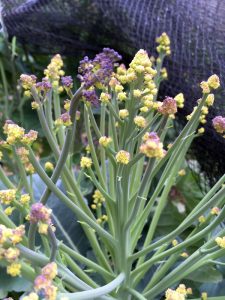 65. Yennie Yong: I’ve been growing romanesco for the first time, and was excited to see the baby head forming a few weeks ago. Then the head split into multiple florets (see photo)! Now I can also see some florets changing to be broccoli-like, more specifically like purple sprouting broccoli. I’m wondering if this could be caused by the romanesco cross pollinating with the some purple sprouting broccoli planted in the same bed. In future, should I only plant one variety at a time to ensure I get true to type results? 65. Yennie Yong: I’ve been growing romanesco for the first time, and was excited to see the baby head forming a few weeks ago. Then the head split into multiple florets (see photo)! Now I can also see some florets changing to be broccoli-like, more specifically like purple sprouting broccoli. I’m wondering if this could be caused by the romanesco cross pollinating with the some purple sprouting broccoli planted in the same bed. In future, should I only plant one variety at a time to ensure I get true to type results? |
Bruno Tigani (who works in commercial horticulture): I think that Yennie’s romanesco simply bolted to seed without first forming a tight head and that this happened because the romanesco was planted too late in the season. Generally, for the home gardener, you should start brassicas in late summer and harvest in winter. If plants go in later, then the plant will remain small during winter, the heads will be loose and small, and they will go straight to seed once spring arrives. The home gardener waiting for their brassica head to get larger in spring will never succeed, as the plant is now in its reproductive phase. Rather, you will get much better results if you plant in, say, February, mainly due to the plant making better growth before the onset of the really cold weather. With cold exposure, the plants will vernalize and that is the cue to form a head, which you harvest, and the head will be larger simply because the plant is larger. I finish planting my cauliflower, Brussels sprouts and large cabbages by end of February. Broccoli and small cabbages you can go well into March. April is too late for winter brassicas in Melbourne if your aim is to harvest a large, well-formed head. |
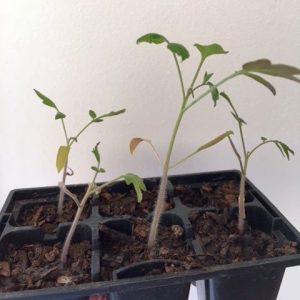 64. Eliza McCumstie: I first encountered herbicide in bought compost a few years ago and lost all my tomatoes. It was devastating and no one seemed to know much about it. This year, I used a certified organic compost to pot my tomatoes up and it’s happened again (see photo), where I used Angelo Eliades’ article on how to identify and treat herbicide contamination of commercial soil, compost and manure to diagnose the problem. I thought I’d be safe with a certified organic product but unfortunately that was not the case. It’s such a waste of effort when you put all the time into growing seedlings only to have to throw them away. Whilst I make my own compost, it is not enough for all my garden beds and I need the convenience of a ready-made product for growing seedlings. So, my question is this: can anyone recommend a safe and trustworthy source for compost? 64. Eliza McCumstie: I first encountered herbicide in bought compost a few years ago and lost all my tomatoes. It was devastating and no one seemed to know much about it. This year, I used a certified organic compost to pot my tomatoes up and it’s happened again (see photo), where I used Angelo Eliades’ article on how to identify and treat herbicide contamination of commercial soil, compost and manure to diagnose the problem. I thought I’d be safe with a certified organic product but unfortunately that was not the case. It’s such a waste of effort when you put all the time into growing seedlings only to have to throw them away. Whilst I make my own compost, it is not enough for all my garden beds and I need the convenience of a ready-made product for growing seedlings. So, my question is this: can anyone recommend a safe and trustworthy source for compost? |
Brendon Bolton: Unfortunately, many companies that sell compost are actually waste industry companies that derive the greater portion of their revenue streams by dealing with waste, which often includes turf thatch from sports ovals, golf courses, etc. The contaminated compost that was sold in recent times was most likely as a result of chemical contamination from the turf thatch and could have been avoided with better protocols and testing. As part of my role (Garden Organics Business Development & Education) at the City of Greater Geelong, we test all of our compost before it goes to market. This is done by simply planting tomatoes, peas and sunflowers into various samples of the compost (these species being good indicators of the presence of residual herbicides). For home gardeners wanting to avoid contaminated compost, I suggest planting out sample pots with tomatoes, sunflower and peas into a mix of 75% potting mix 25% compost and observing the results before using it over their entire patch. They may also consider asking the composter about their processes and protocols. Your readership might also be interested in reading about the many benefits of quality compost as well as fact sheets and case studies at Australian Organics Recycling Association (AORA). |
| 63. Vanessa Shribman: Can anyone suggest how to protect passionfruits? I only had 3 ripe ones last year although there were many green ones which mysteriously disappeared. The same critter took large bites out of the tomatoes. Possums or rats? Any suggestions?. |
Julie French: Maybe possums. They used to eat all mine so I gave up growing them. I know it was them because I caught them in the act. Guy Palmer: Maybe rats. I have found that the bagging of individual fruit can sometimes deter them. |
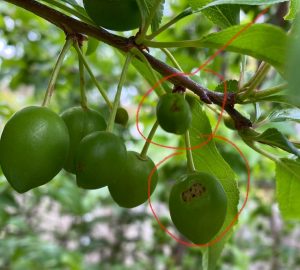 62. Trish Kent: What is eating my plums and how should I treat it? 62. Trish Kent: What is eating my plums and how should I treat it? |
Vera Herman: Read this article, from which I conclude that the problem might well be the caterpillars of a winter moth. |
| 61. Victoria Kanicki: I recently purchased some bergamot, korean mint, valerian and calendula seeds. Despite having looked on the Internet, I can’t seem to find anywhere reliable to advise me on where or how to plant them. In large pots? Straight into the earth? Any other advice? |
Helen Simpson: For the bergamot, mint and valerian, as the seed is small, start in small containers (away from snails, etc). When the seedlings grow to around 5–10cm tall, they can go into large pots or the garden. The calendula seed, being larger, can be planted directly into large pots or the garden (again protect from snails). Penny Smith: For each of the seeds that they sell, The Seed Collection has a useful table with details of their growth method (you have to scroll and I assume that the method ‘raise seedlings’ means grow them in a punnet or pot first and then transplant). So: bergamot, korean mint, valerian and calendula. |
| 60. Sonia Martinez: I want to install some wicking beds in her back garden but I have no experience with them. I would like to know whether I should a) make them herself, b) get someone else to make them or c) purchase a ready made set up such as Foodcube? I would appreciate any thoughts about cost, effort or likely edible results. |
Emily Alexandra: Get your wicking beds from Ceres Fair Wood. Tom Danby: I plan to establish a tailored wooden garden bed service but, because of Covid restrictions, I currently mostly install Biofilta Foodcubes. |
| 59. Shiva Vasi: Aphids have been having a feast on the tender leaves of my roses. Does anyone know of a homemade aphid spray which is suitable for roses? |
Lyn Richards: Water! There are lots of homemade sprays on the Internet and they all work because an ingredient is water. Just firmly spray the buds being attacked with water and dislodge the aphids – they’re too stupid climb back up! Victoria Kanicki: I always use washing up liquid, diluted and in a spray bottle. Suzy Georges: I use this recipe. Ingredients: 4 litres of water, 1 tablespoon of epsom salt, 1 tablespoon baking soda, 2½ tablespoons of vegetable oil and 1 tablespoon of dishwashing liquid. Mix well, put it in a spray bottle and spray on your flowers & vegetables. Don’t spray it on during the day when the sun is shining. |
| 58. Yvonne Iliffe: Over the past couple of months, I have been having problems with cockies, mainly sulphur-crested and corellas, in that they peck bulbs to ground level, peck out seedlings from the veggie patch, nip growing potatoes just above soil level and also nip the tops off flowers. To interrupt this destructive behaviour, I thought about a scarecrow, foil attached to poles or small windmills scattered throughout the garden. I have now put bird netting over the veggie beds but I can’t do this for the whole garden, especially over the bulb beds and flower beds. I have just noticed that my gardenias are coming into bud and my concern is that the cockies will peck off these delightful blooms. Would anyone have any suggestions for this annoying problem? |
Pam Jenkins: After the cockies nipped off my leeks, I stuck some short pieces of bamboo around the edge of my garlic patch and wound string around the patch and in between the plants in a random pattern and height, from trip-them-up height to neck height. The garlic has remained unscathed thus far. My parents used to do this with black cotton to deter the blackbirds from digging up their seeds. The string is tight so the cockies are unlikely to get tangled in it. Simone Boyd: I have used the reflective tape which can be purchased at most hardware stores to keep cockies at bay. I strung up lengths of string across parts of my small scale market garden and put the tape like ribbons along it at random intervals. This was effective for two seasons, until the cockies cottoned on to the fact that it was not dangerous. Still, worth a try. Although you can buy flimsy reflective tape in the garden section, it will tear and become an environmental hazard pretty quickly. Instead, buy the thicker tape in rolls from the building section which has an adhesive backing and stick it back to back around the string, giving you a double sided reflective area. Sigrid McCarthy: I don’t have a solution for Yvonne, but just wanted to send my solidarity. Cockies are such cheeky things. They’ve recently discovered my mum’s protea (see photo near right). Almost everything needs to be in cages these days, which doesn’t exactly make for a charming garden! |
| 57. Louise Nolan: I recently acquired an indoor cat but have a dilemma regarding the used kitty litter. I buy decomposable kitty litter made from corn, which then clumps with the poop and urine and can be flushed down the toilet (as per the manufacturer instructions). I thought that I could throw the remaining corn litter at changeover time into her compost bin. But I have now been told that the contents needs to be left to break down for 18 months to destroy any bacteria, pathogens, etc before being using on the garden, especially on the veggie beds. My question is this: if I place the used cleanish kitty litter into a black plastic bag with some carbon material and then leave it in the sun for a month or so, will the pathogens be killed off in the heat? If so, could I then throw the solarised contents into the compost bin and utilise the compost so much quicker? |
Angelo Eliades: Pet litter, either dog or cat, should never be used in regular composting systems under any circumstances. It should never be used at any stage of breakdown in any garden beds, especially where produce is being grown. The poop carries lots of pathogens and it’s not viable to sterilise it in any way for handling as a garden soil amendment material. It should therefore never be put into a compost bin that needs to be emptied, or mixed into soil that will be dug or handled. The only safe disposal method that would recycle the material is to dig it deep into the soil in areas that aren’t disturbed, such as unused areas, areas under trees (don’t cut into their roots) or mulched garden paths away from veggie garden beds. Jill Renison: I have a similar problem which I have not satisfactorily resolved as yet. Cats carry toxoplasmosis, which can infect other animals. I used to flush cat poo down the toilet, but stopped when I read that sea creatures, such as otters, can be infected by doing this. I keep all cat waste products well away from my compost bins and food gardens. I used to put the urine-soaked recycled paper waste pellets on a non-productive part of the garden, but they take forever to decompose and are unsightly. You can buy special composting buckets for animal waste that you partially bury in the garden, but this doesn’t solve the problem of the used litter. James Petty: I can’t answer your question about solarising the kitty litter but I have been running a little experiment composting my dog’s poo. It goes in a separate small compost bin that I picked up off the street along with a carbon material (straw, dried leaves/grass clippings, sawdust), and regular watering to keep it moist. Plus an occasional shovel-load from my normal compost. It works extremely well (see photo)! The issue of using it on the garden never arises because it breaks down so quickly the bin never fills up. |
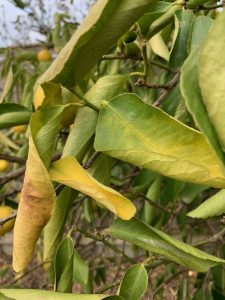 56. Julie Cabrol: What is killing the lime tree (see picture). It’s been well fed and watered and very healthy for years until last year. Lately, however, it’s lost most of its canopy leaves and the rest are yellowing and curly. The two changes to its environment are a fig tree planted 3 metres away and a magnolia planted right across on the other side of the fence. Is it nitrogen deficient (possibly absorbed by the magnolia)? If it is, would pelletised chicken manure, a slow release fertiliser or something else be best? 56. Julie Cabrol: What is killing the lime tree (see picture). It’s been well fed and watered and very healthy for years until last year. Lately, however, it’s lost most of its canopy leaves and the rest are yellowing and curly. The two changes to its environment are a fig tree planted 3 metres away and a magnolia planted right across on the other side of the fence. Is it nitrogen deficient (possibly absorbed by the magnolia)? If it is, would pelletised chicken manure, a slow release fertiliser or something else be best? |
Sandie Downes: The problem may be too much water, given how much it has rained this year plus our clay soils. Angelo Eliades: The lime tree is displaying obvious signs of root loss. Without any additional information, diagnosis is guesswork, as there are several possible causes. When did the symptoms appear, after the dry, windy part of winter, or after the rains started? Was there any digging or re-planting around the root zone of the tree? Was any fertiliser applied and, if so, what type? If I had to make a SWAG (scientific wild-ass guess), there’s a high chance that it’s root rot due to soil waterlogging over winter. Pushing a trowel into the ground and pulling it back to check the soil might be worthwhile to see what’s happening in the soil. Depending on the severity of the problem, unless the problem is remediated, the leaves will start dropping next, and then dieback of the branches will occur, and the whole tree will go shortly after. I wrote an article a while back to help people with their dying citrus. |
| 55. Julie Martin: I have lots of spare grapefruit. Other than make (yet more) marmalade, what should I do with them? |
Bill Brosch: Bake a grapefruit cake (I found a recipe online and was pleasantly surprised how delicious it was) and/or freeze the juice for another day. Sonia Martinez: I separate and preserve the peels, and then poach the flesh with sugar and freeze. Meg Montague: Grapefruit and lime/lemon cordial is a great way to use excess grapefruit. Grate the zest and squeeze the juice of about 4 grapefruit plus a couple of limes or lemons, put fruit skins in bowl too; then add half a cup of stevia (or sugar if you prefer, the amount can actually vary depending on how sweet you like the cordial), 2 dessert spoons of citric acid and one of tartaric acid; pour on boiling water, about a litre to cover; stir to dissolve stevia/sugar; leave overnight; strain, bottle, keep in the fridge and dilute to taste. I have also made this with added squeezed juice from pomegranates which add a marvellous pink tinge and exotic flavour. Kerin Tulloch: I freeze juice for later use in cordials, cakes, etc. I have also just made a winter warmer with Beechworth honey (see recipe). I am also in the process of making some all-purpose citrus cleaner (see recipe). |
| 54. Hanh Truong: I’m pickling limes for the first time and, to remove the zest and the bitter taste, I cook them in boiling water for 2 minutes. After I take out the limes, the water smells beautiful and zesty. It seems such a waste to pour the water down the drain. What else could I do with the fragrance water? |
Claire Smith: Add some sugar and tartaric acid to make a lime cordial. Add a bit of juice to boost the flavour. Wendy David: It would make a good all purpose cleaner in a spray bottle. Citrus is a great cleaning product. |
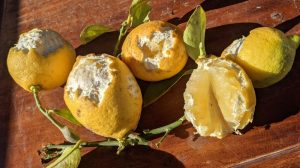 53. Jo Buckle: What is eating the lemon skins off my tree? Possums, fruit bats or rats? Any suggestions about what to do? 53. Jo Buckle: What is eating the lemon skins off my tree? Possums, fruit bats or rats? Any suggestions about what to do? |
Angelo Eliades: Both rats and possums will eat the peel off citrus. If you net the fruit and the problem stops then you have possums, as they can’t get through netting, whereas rats can chew through it. Fruit bats are not known to be a pest of citrus trees. Olwyn Smiley: Our lemons were being left naked like this by possums. A local backyard fruit grower told me that she used cloudy ammonia: a few centimetres in small jars that she hung in or around her fruit trees. In the morning, she put lids on the jars and, in the evening, she opened them up. It proved to be a handy trick because our possums stopped skinning the lemons. I am not as organised as my informant though – I just leave the bottles un-lidded and topped up the ammonia when necessary. Wayne Tonissen: It could be snails, particularly if they are Meyer lemons. |
| 52. Michelle Kohle: The side of our property is planted with large ornamental pear trees and, sadly, they are badly infested with white fly which has also now started to affect our citrus and other shrubs. We are trying to be organic and not use sprays and I understand that ladybirds, lacewings and hoverflies are great predators but they are not around at the moment. We have tried spraying with water but, with so many large trees, this has not been very effective. Is there anything I can do naturally to get rid of this pest? Also, are we able to compost the leaves? |
Bruno Tigani: Use kaolin clay (which is also effective against Queensland Fruit Fly). I think you can buy it as a wettable powder, then mix with water in a spray unit. Take all usual care when working with fine powders as, whilst it’s organic, it can irritate eyes and lungs. Deb Thomson: Follow the instructions from the Eco organic garden website. [This includes releasing green lacewings, eco-oil and eco-neem.] James Petty: You can try making an organic horticultural oil to spray – ¼ cup organic cooking oil (vegetable/peanut/olive) plus ¼ cup organic/natural laundry or dish soap to five litres water plus (optional, for extra oomph) a few drops of organic eucalyptus/peppermint oil. Such a spray will, however, also kill other insects on the plants (including whitefly predators). Another option is giving everything a brutal prune – in my experience, the most effective response to whitefly is getting rid of what they are eating. It’s sad but effective. Finally, you can compost the leaves, especially if have enough for a hot compost which will kill the eggs. |
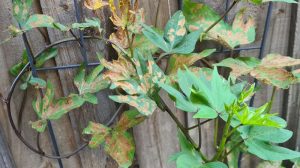 51. Mary Turner: A disease on the leaves of my sweet potatoes started slowly but is gradually overtaking the whole plant. What is the disease and do I need to destroy the plant before harvest? Also, how to I tell when my sweet potatoes are ready to harvest? 51. Mary Turner: A disease on the leaves of my sweet potatoes started slowly but is gradually overtaking the whole plant. What is the disease and do I need to destroy the plant before harvest? Also, how to I tell when my sweet potatoes are ready to harvest? |
Angelo Eliades: The photos are taken too far away for accurate diagnosis but if the brown patches have a yellow halo around them and they are on older leaves which eventually drop, then it’s likely to be the fungal disease Alternaria leaf spot. This disease is more prevalent when dry and rainy periods occur, or when plants are watered overhead wetting their leaves, especially in the evening. Harvest sweet potatoes when the leaves and ends of the vines begin turning yellow. [Editor: I harvest when the vines die back but, if in doubt, I leave them a bit longer as most of the bulking up is done in the last few weeks.] |
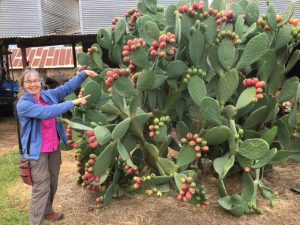 50. Cathy Romeo: I recently bought some prickly pear fruit in Mount Beauty – I spotted them on the nature strip as I was driving, where an elderly couple had little fruit stall. Although I have bought some for now, I am interested in knowing where one can get them from in Melbourne. Can anyone suggest anywhere local where I can buy prickly pear fruit? 50. Cathy Romeo: I recently bought some prickly pear fruit in Mount Beauty – I spotted them on the nature strip as I was driving, where an elderly couple had little fruit stall. Although I have bought some for now, I am interested in knowing where one can get them from in Melbourne. Can anyone suggest anywhere local where I can buy prickly pear fruit? |
Mick Sheard from Imbue Distillery: We use prickly pear fruit in our gin. It is very difficult to buy in the shops and we usually get ours by either foraging (e.g. in Wattle Glen) or from roadside stalls (e.g. in Melton). Linda Wall: I’ve seen them for sale at Preston Market. I also have a prickly pear cactus in my garden and am happy to sell some of the fruit. |
| 49. Guy Palmer: Can anyone suggest where I can buy custard apple fruit (not the plant, just the fruit)? |
Karen Olsen: I have found custard apples at the Vic markets and several Asian food grocers. I discovered custard apple when I moved into my first share house at university. Every week, one or two housemates would do the weekly shop at the Vic markets – the variety of the whole market, including custard apples, was a food revelation! Helen Simpson: Many years ago I used to buy them in Coles. We used to have an ‘unusual fruit tasting’ every week and custard applies often featured. Choon Yeok: I have bought custard apples from Woolworth and Coles before. |
48. 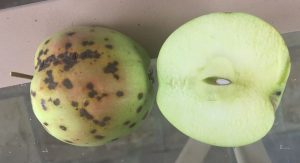 Vicki Jordan: Almost all of my golden delicious apples, but none of my jonathans, look like the photo. As you can see, the disease is only on the skin and does not penetrate into the flesh. Does anyone know what the disease is? Vicki Jordan: Almost all of my golden delicious apples, but none of my jonathans, look like the photo. As you can see, the disease is only on the skin and does not penetrate into the flesh. Does anyone know what the disease is? |
Bruno Tigani and Lyn Richards both wrote it to say that it is ‘apple scab’, which is a common disease caused by the fungus Venturia inaequalis. Bruno referred Vicki to this web page. Lyn added: My guess is that golden delicious are vulnerable for just the reason that we grow them – thin skin, moist fruit, deteriorate rapidly off the tree. The good news is it’s cosmetic only, doesn’t harm the fruit, but pity the apple farmer who gets it. And it clearly can get nastier – if you Google ‘apple scab’ you get horrific images of far worse damage than you have, and to the leaves as well. Control measures are the usual for fungus – clear fallen leaves and fruit, keep base of tree clear, avoid overhead watering. Read this Agriculture Victoria page. Plant resistant varieties – I can’t find a list of them, but one appears to be my heritage Rome Beauty apple – not a spot on its huge red fruit. |
| 47. Rebecca Haschek: Where can I buy some ‘point of lay’ (POL) chickens. I don’t want ISA browns … I’d rather get some heritage breeds as I want a number of chickens to help process my organic waste and don’t want to be overrun by eggs. Friendly, gentle breeds are a must for the kids. Bantams are ok too. I’ve found some breeders, but they are over an hour away and I’d rather get them from the local area if possible. I live in Diamond Creek. |
Here are some suggestions:
Yummy Gardens got the most nominations. As Gina Wilson said: Greg [Parsons] has been breeding and selling chickens for years, with my latest chicken from him being a crested cream legbar who lay blue eggs (see the dark brown chicken in the photo). He also builds chicken coops, like mine, to suit individual needs and backyards. And he designs and constructs vegetable gardens. |
| 46. Hanh Truong: I have used bokashi before and I just don’t like the idea of pouring chemicals back into the garden. I remember tipping the waste into my compost bin and the worms wiggle like they don’t like it so I stopped using the bokashi bin. What are your thoughts on pouring chemicals into kitchen waste and then back into our garden? Also, is composting better to have than a worm farm? |
Tom Danby: The bokashi juice is the contents of plant cells, released by the fermentation/rot process, so it is not surprising that the worms object. It should be diluted at least 1:20 or 1:100 before spaying back over the plant. It is concentrated minerals, enzymes, plant proteins and more, so technically chemicals but with no pejorative overtones. Robin Gale-Baker: Bokashi mix contains living micro-organisms, wheat bran, rice husks, water and molasses – none of which are ‘chemicals’. It is an excellent addition to compost. If I had to choose between a compost heap and a worm farm, I would always choose compost but they have different applications so both are valuable for the gardener. If you do not want to attract vermin to your compost, then a combination of bokashi and worm farm works well for food scraps. Lucinda Flynn: Bokashi bins use a process of fermentation to break down organic waste, as opposed to decomposition (which is what happens in a regular compost bin). The powder that you sprinkle on a bokashi is not a chemical as such; rather, it is living microorganisms stored in an inactive form in a grain base. You can compare it to freeze dried baker’s yeast, which remains inactive until you mix it with warm water. Once the grain base is sprinkled into the bokashi bin and gets wet, the organisms come to life and start fermenting your food scraps. When you put your bokashi scraps into a compost pile, the worms might not like it initially because it is probably a bit acidic – think of wine or vinegar, both fermented. But it is still good, healthy material to add to your garden. Angelo Eliades: There aren’t any ‘chemicals’ with bokashi. It utilises a combination of microorganisms to ferment food scraps and the end product is acidic, just like yoghurt. Fermented bokashi can be dug into the ground or put into compost bins. Most people don’t understand which garden recycling systems should be use for what purpose. Compost is for garden waste, prunings and clippings which break down slowly; worm farms are for kitchen waste which breaks down quickly; and bokashi is for kitchen waste, including foods that can’t go into worm farms. Food scraps can go into compost (and many people do it) but it attracts rodents and worm farms and bokashi are better systems for processing them. If there are worms in your compost, this is an indicator that ready to use and should be placed in the garden. I have written a number of relevant articles on my website: Bokashi composting, how to process waste that can’t go in your compost or worm farm; What materials can you put into your compost bin and what not to compost; and Can you put earthworms in the compost bin?. Charles Dickerson: Bokashi does not use ‘chemicals’ at all. You either spray a liquid or sprinkle a bran inoculated with microbes onto your food waste. These microbes then ‘pickle’ your food waste (hence the vinegary smell). You can then either add it to the ground directly or add it to the compost bin. I think of bokashi as a pre-compost step and the longer you keep it in its container the more pre-composted it gets. To add it to the ground, dig a hole and bury the waste at least 10-15 cm down is the traditional method. Place wire netting over the hole to keep your dog from digging it up. It is completely broken down in a month. To add it to a compost bin, mix some straw/leaves through the waste beforehand to blot up any liquid (if you add the neat waste it will upset the worms as it is acidic). I also place a 30-50mm layer of straw/leaves in the compost bin first as this keeps the waste away from the worms until it has broken down. The benefit of bokashi over a worm farm is you can put any sort of food waste in the bin. Citrus, oil, meat can be added to bokashi whereas that’s a no no for a worm farm. Regarding oil, blot it up with shredded copier paper (from a home paper shredder) and then add that to the bokashi bin. Mary Rogers: My compost bin is a worm farm. I think the worms are the garden variety and they love living there. |
45. 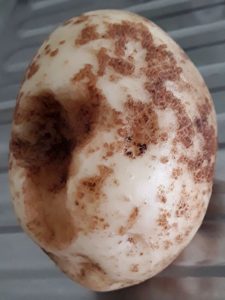 Pauline Webb: What grub or slug is eating my potatoes while they are in the soil? Is this skin potato scab or something else? How should I control it? Pauline Webb: What grub or slug is eating my potatoes while they are in the soil? Is this skin potato scab or something else? How should I control it? |
Angelo Eliades: If the rusty discolouration visible on the potato is only skin deep and has ragged edges, then the problem is potato scab. This condition is worse in light soils under dry conditions. To prevent it, dig in compost before sowing tubers and do not add lime to soil. If, however, there are large holes eaten in the flesh of the potato tuber, that’s a sign of slug damage (slugs can burrow and feed underground). Aimee Maxwell: It looks like potato scab to me. Read the treatment suggestions Plant Natural Research Center website. Vera Herman: If Pauline searches for ‘potato diseases in Australia’, there are lots of info and pictures of potato diseases. Did Pauline check that her soil was slightly acidic? Did she plant seed potatoes & practice crop rotation? Diggers recommends a 3-year crop rotation for potatoes, i.e. don’t plant potatoes in the same spot for 3 years. |
| 44. Alison Raven: Is there any way of recycling the old fruit tree netting that will be illegal come September, when the netting laws in Victoria change? Agriculture Victoria says: ‘When disposing of the old netting, reduce the chance of further entanglements by placing the old netting into a strong biodegradable bag before putting into landfill.’ I don’t want to put it in landfill unless there is absolutely no other option. I assume it is made of some kind of plastic, so I would have thought it could be recycled somehow. There will be mountains of old nets going into landfill otherwise. |
Nillumbik Council: Unfortunately we have not been able to source any options for recycling plastic netting material. REDcycle: Whilst the material itself may be able to be REDcycled (only if it is polypropylene PP, LDPE or HDPE, not if it is actually nylon), the problem with this is that they have had long exposure to the sun, meaning the plastic has already started to deteriorate (and some are often quite dirty as well). Any materials in this state cannot then be used, as it impacts the structural integrity of the final products made from the plastics. Further, unfortunately we are not actually able to accept commercial/industrial or large volume soft plastics like this. Even if the bird netting is clean, it would all need to be cut to A3 size pieces or smaller before we could accept it, otherwise it becomes entangled in the processing machinery. |
| 43. Susan Arnold: My beans and other veggies are covered in tiny white bugs with wings (aphids?). When I hose, it disrupts them and they swarm around the plants but then return. I have tried garlic spray then Eco oil, but it seemed to burn the leaves and have little effect on the bugs. What are your recommendations please? |
Susan (replying to her own question): I have done some investigating myself and the bugs I have are whitefly. I have found that vegetable oil combined with dishwasher liquid diluted with warm water in a spray bottle works a treat. I have sprayed my beans, tomatoes, zucchinis and cucumbers and the bugs are now mostly (95%) dead. The plants remain lush and healthy days later. Angelo Eliades: Tiny white flying insects that swarm when you spray then with water sound exactly like whitefly. They are tiny moths and can be controlled with eco-oil, neem oil or horticultural soap. Horticultural oils should never be used when the temperatures may reach 30 degC or more, as the leaves will burn, and that sounds like what might have happened with Susan. On really hot days, just hose the bugs off with a moderate pressure spray to reduce their numbers. Clare Quinlan: It sounds like whitefly. A vacuum cleaner can be great to sucking the majority off. Constantly disturbing them is great to, but can get exhausting and boring standing there all day disturbing tiny creatures from eating their dinners. Garlic spray and eco can work but only if it gets on the actual fly apparently. I aim to leave whitefly up to beneficial insects like ladybugs and lacewings. I also leave my fennel to go to flower which creates a ladybug nursery where their numbers grow over summer. Anjana Mukherji: Try 1 litre of tap water 2 drops of washing liquid soap and 4/5 drops of Neem oil. Shake well and spray.
As for treatment, they resisted everything I tried: horticultural oil, neem, coffee spray – nothing worked. The most effective was a combination of vacuuming (daily) and ‘puffing’ diatomaceous earth all over the plants (leaves, stem, underside leaves). However, this took a long time and the puffing is also likely to impact beneficial bugs like predators and pollinators. And within a week, the hoppers were back to full numbers anyway. I have resigned myself to their presence and tried to reduce their habitat. They seem to love rosemary so I pruned it back to a stump. |
42.  Velyne Moretti: Is this the dreaded Queensland Fruit Fly? Velyne Moretti: Is this the dreaded Queensland Fruit Fly? |
Angelo Eliades: The small puncture marks with oozing sap look like QFF to me. The possible alternative is codling moth, but this would leave a larger hole in unripe immature fruit, with brown residue exuding from the hole as the larvae eat their way through the apple. Cutting the apple will yield a definitive answer. White, banana-shaped 1mm long eggs just below the skin, or a small creamy yellow carrot-shaped maggot 8-11mm long with dark cutting jaws at the narrow pointed head end which bends into a U-shape and jumps, indicates that it is QFF. If it’s codling moth, the culprit will be a plump, large, fast crawling caterpillar with a shiny rounded brown head. |
41. 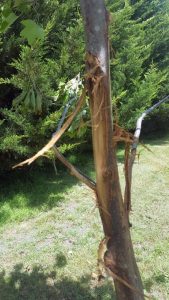 Mary Shiel: I have a tulip tree (Liriodendron tulipifera) that has been growing well for about 6 years but that is now looking very sick, having been attacked by something (see photo). The damage starts at about 120cm from the ground. I’m assuming that it’s a kangaroo attack, as we do have a lot of kangaroos around. Do you agree? More importantly, is there anything I can do to save the tree? Some of the lower branches are now starting to die, although a couple still look quite healthy. Mary Shiel: I have a tulip tree (Liriodendron tulipifera) that has been growing well for about 6 years but that is now looking very sick, having been attacked by something (see photo). The damage starts at about 120cm from the ground. I’m assuming that it’s a kangaroo attack, as we do have a lot of kangaroos around. Do you agree? More importantly, is there anything I can do to save the tree? Some of the lower branches are now starting to die, although a couple still look quite healthy. |
Heather Stanley: Arborist here. It’s feral deer rubbing their antlers on the tree. It’s distressing (for both you and the tree!) but not necessarily a death sentence for the tree. Keep your tree mulched, water it on hot days and give it a monthly dose of seasol. The wound will gradually seal over as the tree continues to grow, don’t paint it or put anything on the exposed tissues. Consult an arborist if you notice any insect activity or weeping from the wound. |
| 40. Anita Merson: Many of my plums (that are green just now and about 1-2cm big) are falling off my tree. The tree has a lot of fruit and it is not all the fruit that is falling off; rather, it is just the smaller ones. Is this just natural fruit thinning or is it a problem? If the latter, what might be the cause and how can it be avoided in future? |
Angelo Eliades: There are three questions that need to be answered to identify the cause:
|
| 39. Louise Nolan: How can I get rid my garden of both whitefly and thrips? I’ve never had such huge numbers before, plague proportions on nearly every single plant in my garden. I have no idea why this has occurred. I don’t spray with any non-organic products but I do use Eco bio oil and Eco Neem. |
Angelo Eliades: Whitefly and thrips can be controlled with horticultural oils such as eco-oil or neem oil sprays, but it’s better to let predatory mites do the job. These beneficials thrive in mulch layers above soil, so it’s important to keep the soil mulched to give them a home. Also, don’t dig up every bit of soil, as this destroys their habitat and kills them (and all the other soil biota too). Heather Miller: In a spray bottle, mix together, 1 litre of warm water, 1 tablespoon of molasses and 1 squirt of dish detergent (preferably organic). Mix and spray over the affected plants, making sure to spray on both sides. |
| 38. Susan Faine: How do you make firm yoghurt from low fat milk without adding milk powder or gelatine? I’ve found that if the culture is full fat it works but, as the generations of yoghurt follow from the preceding batch, and the fat content is increasingly diluted, the yoghurt doesn’t set much at all. | Maria Ciavarella: I strain my yoghurt through a very fine mesh to make it thicker. You can use the whey left over in cooking too. |
| 37. Nancy Mills: Has anyone actually tried composting any kind of recently-produced packaging materials labelled as compostable or home-compostable and, if so, what was the end result? | Lucinda Flynn: Certified home compostable products (to Australian standard AS5810) are really easy to home compost (as they must be to achieve the certification). So this is things like the compost-a-pak corn-starch bags, and sugarcane fibre plates and bowls. Commercially compostable products are not guaranteed to compost in a home compost, usually because they have a need for either heat or movement to start of the process. However, I have been able to home compost the certified commercially compostable Biopak biocups (FSC pulp with a thin lining of PLA bioplastic) pretty easily in my home compost (even though they are not certified home compostable). My home compost is not that hot and I just leave it to do its own thing (but I do give it a mix of food scraps with carbon – such as straw). Single cups are not a problem but it would be harder if you threw in a stack of biocups all joined together. |
| 36. Rebecca Gray: I want to plant a grapevine and need to understand how far reaching its roots will get. I have clay soil and have had cracking problems on the house (brick walls) with other vegetation planted close to the house. How far away should a grapevine be planted to avoid cracking a brick wall? | Senia Kazar: Our grapevines are planted right next to some walls and there has never been any cracking. |
| 35. Jacinda Brown: Can I graft a fruiting grape onto an ornamental grape? |
Angelo Eliades: Ornamental grapes are either Vitus vinifera, whose leaves look like regular grapevine leaves, or Vitus coignetiae, also known as Crimson Glory Vine, which has broad, slightly lobed leaves. Here in Australia, both our table grape and our wine grape varieties are the Vitis vinifera species. So, if your ornamental grape is Vitus vinifera, you can graft fruiting grapes onto it. If your ornamental grape is Vitus coignetiae, I’m not sure if you can graft fruiting grapes onto it. A literature search yielded no results but it is common practice in agricultural settings to graft Vitis vinifera onto other Vitus species rootstock for disease resistance, and several other grape species are used for the purpose, so it’s quite likely that you can do the grafting. |
34. 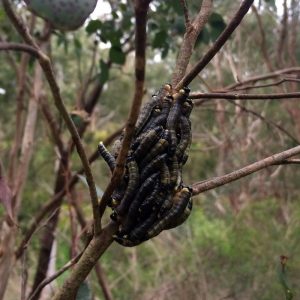 Doris Glier: These larvae were on a gum tree. Does anyone know what they are? Doris Glier: These larvae were on a gum tree. Does anyone know what they are? |
They are spitfire sawfly larvae (genus perga, family pergidae, suborder symphyta, order hymenoptera). Stuart Rodda: They move vigorously when touched (with a stick) and can spit out a nasty liquid as protection. If you do disturb them, don’t stand under them unless you want a shower. Anna Sanders: There are 200 known species of sawfly in Australia and we have found some in our garden too. Have a look at this video of them that I recently made. Read this page about spitfire sawflies. Museums Victoria: they are one of the species of sawfly in genus Perga but it is not clear which. Despite the name, sawflies are actually more closely related to wasps than to flies. The larvae can exude a distasteful substance which probably makes them unpleasant for birds to eat. Contrary to what you might have been told as a child, they don’t actually spit at people but rather dribble an unpleasant tasting substance. Wikipedia: During the day, the larvae congregate in clusters of 20 or 30 for protection and disperse at night to feed. When threatened, the larvae will raise their head and eject a strong-smelling yellow-green liquid, consisting predominantly of eucalyptus oil, to deter predators. This action gives them their common name of ‘spitfires’. |
| 33. Nancy Mills: How to you dispose of takeaway coffee cups? I’ve tried putting biodegradable takeaway cups in a compost bin. Over time, the cups start to break down, but they don’t fully degrade in the time that it takes to compost other compostable materials. And the ‘biodegradable’ lids don’t seem to change at all. Has anyone succeeded in fully composting the cups or the lids? |
Jules Jay: There are big differences between the terms biodegradable, compostable, and home compostable. This page from the CSIRO website explains some of the differences. Biodegradable items (like the coffee lids) should be avoided if possible, as they’re often made from plastics that simply ‘break down’ into millions of tiny pieces (becoming microplastics), rather than reverting to natural substances that feed soil. This degrading process can take many years, so they’ll likely never break down in a compost bin. Compostable items can also be confusing, as they fall into two categories. Much of what’s labelled ‘compostable’ can only be broken down in industrial composting facilities at high heat levels over a specific time period – and certainly not quickly in a home compost bin. Unfortunately, as there are a limited number of industrial composting facilities in Australia, not all compostable materials placed in the recycling bins will go to a proper facility.
Carrie Newbold: I spoke to one of the companies that sells them a few years back. They are only made to decompose in the high temperature commercial composting facilities. I am pretty unimpressed by this, as no one can access one of these (although I do believe the zoo has one). So I became one of those annoying people who would tell anyone who’d listen the ‘truth’. Pretty sure my effect has been nil though. Angelo Eliades: Many ‘biodegradable’ materials, such as the coffee cup lids, only break down under hot composting conditions that sustain high temperatures of 55-65 degrees Celsius for extended periods (2-3 weeks), such as those of commercial composting operations, or home hot composting systems, or over very long periods of time (years) in cold composting systems. Hot composting systems will also make woollen jumpers, cotton shirts or leather boots disappear over the same period of time, just to keep things in perspective. Even though many of these materials don’t break down very easily in slow cold composting conditions, they are technically still ‘biodegradable’. |
| 32. Lyn Richards: All sources I’ve found say that white-winged choughs only eat insects but I am convinced that the attacks on my tangelo crop were from choughs, since they mobbed around it and, when they left, I found numerous pecked and hollowed out fruit on the ground. | Louise Currie: According to The Handbook of Australian, New Zealand and Antarctic birds, Vol 7, part A, pages 777–779. Food: mainly insects and seeds, but also other invertebrates, fruit, shoots and plant tubers. Behaviour: forage almost solely on the ground, among leaf litter and soil (one study showed 99.6% on ground, another 100%). Citrus is not specifically mentioned. I wonder whether it was windfalls that they were eating, not fruit on the tree, or maybe they could knock Lyn’s tangelos from the tree and then eat them on the ground. |
| 31. Annelise Tedesco: I have rhubarb growing in a pot in my courtyard and yesterday I noticed that part of the leaves have been eaten and there is black poo around the base of the pot. I think there are rats getting into my courtyard at night. I have a cat and we have never had this problem before. How do I deter them from my garden without poison? |
Katrina Forstner: If the rats are in the compost bins, you can do a few things. 1. Pop some neighbour’s bokashi bin contents in as the fermented scraps is something they abhor. 2. Use galvanised aviary wire on the bottom of the bin (although I’ve seen determined rats still get through). 3. Mix your compost regularly, give it a loud tap every time that you go past and water the compost from time to time. I’ve heard (though not tried) that opened containers of toothpaste deter rats. Finally, I protect my edible plants with upcycled freezer baskets that I’ve found in hard rubbish, plus I’ve recently found that aviary cages are perfect with their small gauge or mesh. I have used rat traps bought from hardware shops effectively. The problem is disposing of the caught rats. There are many YouTube clips using a large (usually glass) bowl filled with olive oil, sometimes with a ‘walking plank’ with a food lure overhanging the oil. The plank collapses and the mice/rat can’t get out because it’s too slippery. Place orange nets of cat hair around the garden. This also deters possums. |
| 30. Susan Faine: I want to buy some injera flatbread and have it delivered to a friend in Doncaster. Does anyone know of anywhere where I can order for Doncaster delivery? | Catherine Mortimer: Injera flatbread is easy to make with three ingredients and a non-stick frying pan. I have only ever made it myself (or eaten it in a restaurant) and have never seen it sold anywhere. I would be happy to send a recipe or show someone online if they need. |
| 29. Emily Lim: I am looking for insect/cabbage moth cover or exclusion nets. What type should I get and where should I get it from? | Robin Gale-Baker: Fine white net bought off the roll from Bulleen Art & Garden nursery is my preferred net. It is very wide which is much more useful than packaged nets which are about half the width and often do not provide enough coverage. |
| 28. Dassana: Last summer, after a blast of heat, all my bean and tomato flowers died and it took ages for them to send out new ones and so for fruit to set. Any tips on managing weather extremes? Also, why do the tops of zucchini flowers sometimes rot? | Robin Gale-Baker: Deeply water for a number of days before the heat starts – a well-watered plant will not be stressed. Scrape away some topsoil to make sure the water is penetrating. Cover the plants with some kind of shade cloth or even old sheets. I knock 4 star pickets into the ground, attach some kind of covering and secure with yellow star picket caps. Alternatively, grow your vegetables in a wicking bed. |
| 27. Chris Kent: Does anyone else suffers with attacks on their citrus during the winter? | Meg Montague: We are on the fruit bat flight path from Horseshoe Bend to the city gardens and have been suffering from bat attack this year for the first time! The bats go for the oranges on the topmost branches of our 10 metre high orange tree, hollowing out the fruit at night. In addition, during the day we have seen wattlebirds sipping at the juice of the opened fruit that are still hanging on the tree. We don’t really mind as we can rarely reach the fruit at the top of the tree, but I am wary of handling the fallen oranges without gloves due to potential bat viruses! |
| 26. Doris McAllister: Why I can’t collect any worm juice? I have a plastic 3 litre kit, it’s tilted and the tap is clean but still no juice. Any suggestions? | Jo Buckle: There is no ‘juice’ because what’s in the worm farm is dry (e.g. dry leaves). There will only be liquid coming out if the contents are wet (e.g. rotting lettuce). If you want to test that the drainage isn’t blocked, pour some water in and see if it comes out through the tap. Some people think that the ‘juice’ is valuable worm tea, but it’s just seepage from the contents. Worm tea is made from diluting worm castings (the smooth, black finished product after your worms have eaten what’s in the farm).
Rebecca Haschek: Worm juice as described by Doris is actually called leachate and is the product of an over-moist worm farm. An over-moist worm farm leads to anaerobic conditions and can actually be a breeding ground for bad bacteria. A healthy worm farm is moist but does not produce leachate … if you take a handful of bedding and squeeze it, it should at most produce one or two drips. Leachate can be used on the garden but, as it is possible for it to have bad bacteria, it is not recommended for edible plants and should certainly be kept away from edible leaves. Having said that, many people who don’t know this use it without a problem. If you want to make worm tea for your edible garden, you can make a worm casting tea bag, then steep it in some aerated water overnight. An old aquarium air bubbler or similar will keep the water aerated and stop any anaerobic activity. Worm tea can be used on edibles as long as they are rinsed thoroughly before consumption. As an aside, sometimes worm farm instructions suggest pouring water through the farm periodically. However, as well as creating leachate, this can make the bedding too moist for the worms and attractive to unwanted creatures such as pot worms and mites. Angelo Eliades: Worm farms only produce leachate when there is excess water. If your warm farms are kept outside, keep the tap open with a bucket underneath. After it rains, there will be a bucket of worm wee to collect. Most fruit and vegies are around 80-90% water so, if you’re adding enough kitchen scraps, there should be excess water and there will be small amounts of leachate draining through into the bottom tray of the worm farm. Using a worm blanket or whole newspaper to cover the food scraps helps retain the moisture and creates a moist, protected environment for the worms to feed in. The bedding material of any worm farm should be as moist as a squeezed out sponge; if it’s drier than that then it will soak up any moisture released. Maria Ciavarella: Winter food scraps tend to be less wet than the scraps that you might supply your worms in the warmer weather. So that’s why there’s less worm wee output in winter. It won’t harm your worms to give them a little shower every now and again and you’ll soon hear the dripping of the leachate going into your liquids’ tray. Do this by using a watering can over the worm blanket covering so as not to shock them instantly! Also, it might be a good idea to lift off the worm trays and see what is happening in the liquid accumulator tray. You might find a lot of castings have made their way into this tray and are blocking the tap. Sam Dixon: I get more worm juice when I very carefully aerate the contents of the worm with my hand trowel. I do this at least once a week. |
| 25. Melita Proebstl: Will my her strawberry fruit ripen at this time of year (Winter)? | Helen Simpson: Whilst some strawberry plants will fruit all year, the fruit won’t ripen fully in Winter due to lack of sunlight. |
| 24. Paul Hemsworth: Why do earthworms end up drowned in our bird bath? Admittedly it’s at ground level but it’s on concrete tiles at least half a metre from soil. What is the attraction of a plastic container of water? |
Michelle Cheah: It seems that earthworms are attracted to moisture. They come out of the ground on a rainy day not to escape drowning in the ground but because the extra moisture helps them take in more oxygen through their skin and also to migrate longer distances across soil. They can move further over wet soil overground than they can underground by burrowing. The pool of water in the birdbath is concentrated moisture so that is probably what is drawing them towards it. I have also found that earthworms don’t drown per se and can live fully submerged underwater for days, although extended exposure to sunlight can paralyse them and make them appear dead. I suggest that Paul checks the bird bath daily and rescues any that he finds. Alternatively, raise the bird bath if practical to do so. Deb Thomson: I am assuming the earthworms are seeking out that extra moisture and then drown. Perhaps Paul could try wiping the outsides of his bird bath, down to the ground, with eucalyptus oil to see if this deters the worms on their suicide mission. Tracey O’Neill: I have seen birds dropping earthworms into a bird bath. Perhaps they don’t realise how deep the water is and are unable to fish the worm back out? Peta Heywood: I think birds (magpies) go to have a drink and leave their worm behind. I can’t prove it yet. |
| 23. Beata Clark: I’m looking for advice about sustainable potting mix, particularly the mineral content. I’d like to make my own and I produce a lot of compost but need something to improve drainage. I don’t feel good about using river sand. The British use a lot of grit, which is a quarried product. Is there anything I can use that is more eco-friendly? | Saimon Boyle: 50% sand to 50% compost should provide both the drainage and the nutrients needed. |
| 22. Georgina Aquilina: has anyone got any tips for keeping possums away from veggie boxes? |
Angelo Eliades: The easiest way to keep possums out of veggie beds is to cover them with 10mm woven bird netting or, even better, 2mm insect exclusion netting (which also provides 20% shade). Just use some cloche hoops or other supports to hold the netting up to give the plants root to grow. The insect netting, as the name suggests, will also keep insect pests out and comes as either 2.8m wide or 6m wide netting on a roll, so you can purchase the length you require to cover the garden bed. Elle Lawrence: A hungry possum will eat anything; goodbye to anything with flower heads on them also. The only way to protect your hard work in the garden is to have a barrier they can’t get into. I’ve used possum repellants of every type but they don’t work. I finally resorted to building a walk-in, wire-covered structure with gates. As shown by the scat on the ground, they crawl over the top of the wire roof trying to get in. |
| 21. Darryl Wilson: My wife is looking into medicinal plants for pain relief, healing of injuries and reduce inflammation. Are there any courses that she may be able to pursue? The back story is that her brother is paraplegic living in a third world country with limited medicines. His welfare is of concern to us and this is our next step into looking for other aides for his condition. |
Melissa Tripodi: I am studying naturopathy and have plenty of resources on medicinal herbs to share with Darryl. The Shift Network has some courses on aspects of mind body medicine. Pam Jenkins: the Department of Nutrition, Dietetics and Food at Monash University runs a free, three week online course entitled Food as Medicine. |
20. 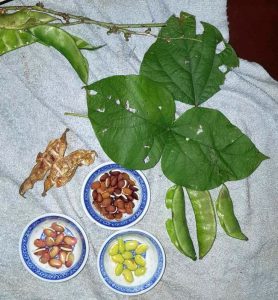 Stella Ramos: This plant is growing in my brother’s backyard. What is it, is it edible by humans and can he feed it to the birds? The dark beans are those which are dried out. The pods are a bit fluffy. All the beans have a distinct white line along the edge. My brother is not sure if it’s safe to eat but he tried some and says it tastes a bit like peas but not as sweet. Stella Ramos: This plant is growing in my brother’s backyard. What is it, is it edible by humans and can he feed it to the birds? The dark beans are those which are dried out. The pods are a bit fluffy. All the beans have a distinct white line along the edge. My brother is not sure if it’s safe to eat but he tried some and says it tastes a bit like peas but not as sweet. |
It is a hyacinth/lablab bean (Lablab purpureus). Here are some relevant links: How to grow hyacinth or lablab beans (video), how to grow hyacinth been vines, fair dinkum seeds and Wikipedia. Karen Ye: In Asia, we eat them properly cooked. The raw ones may be poisonous. According to Wikipedia: the fruit and beans are edible if boiled well with several changes of the water (otherwise, toxic); the leaves can be eaten raw or cooked like spinach; the flowers can be eaten raw or steamed; the root can be boiled or baked; and the seeds can be used in tofu or tempeh. |
19. 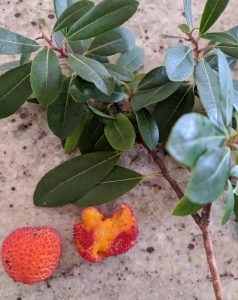 Velyne Moretti: Can anyone tell me what this is? It looks like a lychee but is mushy orange inside. The birds love them and this tree is next door. Velyne Moretti: Can anyone tell me what this is? It looks like a lychee but is mushy orange inside. The birds love them and this tree is next door. |
The answer is Irish strawberry tree (Arbutus unedo).
Angelo Eliades: The fruit is edible but very gritty, tasting like strawberries and sand mixed together! Karin Motyer: I’m sure that you and others know that Velyne’s photo is of and Irish strawberry. [Editor: well we should know because Karin herself sent in a picture of one for our 13th May newsletter.] Maude Farrugia: I wrote a guide to them in the latest issue of Pip Magazine, including recipe for very yum Irish strawberry jam. Pam Jenkins: I have never tried them but you can make jam with them. I have heard that they are not very tasty just straight off the tree and that the jam is not much better! Ros Hardy: As Velyne says, the birds love them but I am not sure if they are suitable for human consumption. Shelley Evans: Last week I made feijoa and Irish strawberry sorbet. I then used this as flavouring for my homemade ice cream. My very fussy family loved it and want more but they will have to wait until next year’s harvest. Stephen Onians: The fruit is edible when ripe. It has a slight narcotic effect and should not be eaten in large quantities. It makes good jelly. Your local council may have it listed as a weed. |
18. 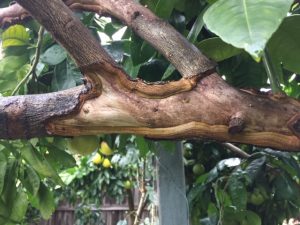 Jan Akeroyd: Does anyone know what is going on with this grapefruit tree (see picture)? It is an older tree which is healthy and productive but which has multiple areas where, like in the photo, the bark is missing on its branches. Jan Akeroyd: Does anyone know what is going on with this grapefruit tree (see picture)? It is an older tree which is healthy and productive but which has multiple areas where, like in the photo, the bark is missing on its branches. |
Velyne Moretti: I think it is because the tree may have been in mild drought and must have received some big, big rain which quickly expanded the trunk, causing it to split. So nothing is wrong with the tree. Carrie Newbold: We had a similar occurrence with our kaffir lime tree this year. We blamed rats for eating the bark. The fully ringbarked branches eventually all died. Thankfully the tree is a 3-4m monster, and has seemingly brushed off their alleged poor behaviour. |
| 17. Gerard O’Donnell: I planted capsicum seedlings a while back. They’ve grown and fruited rather well. I expected that the fruit would change from green to red but, instead, they have stayed green and developed black stripes (see photo). Is this black colouring natural or is something wrong? |
Bruno Tigani: The black or purple stripes are very likely to be anthocyanin development in the fruit. This is probably due to colder temperatures, such as the very cold nights recently, with the anthocyanins being a protective mechanism in the plant against the temperature. Many vegetables exhibit this discolouration if it gets very cold, such as purpling in broccoli. The capsicum fruits are ripening very slowly now and may not turn red at all, as it is too late in the season here in Melbourne. If the fruit did mature to full colour, then the streaks would fade and you would be left with a red capsicum. Pauline Webb: My observations of my own capsicums when they have dark marks or lines is that it is always late in the season when there is a lack of both sun and heat. At this time of year, no capsicum can turn red. It pays to pick them before they have little visitors inside as caterpillar frass is near impossible to wash out. Moira Tucker: I think it is just a natural mutation and/or a cross of colour types. Keep the seed and see if the colour variation is stable as it has potential as a variation! |
| 16. Shiva Vasi: I want to get a trailer load of manure (ideally sheep or cow) for my garden, thereby avoiding plastic bags. Can anyone suggest where I can buy manure in bulk? |
Angelo Eliades: Bulleen Art & Garden nursery sells bulk cow manure. You can either get it delivered, fill a trailer, or borrow the courtesy trailers that they have. Claire Smith: Whilst it is bagged, it is possible to get free manure from the RSPCA in Burwood East. If you ring them (9224 2222) and ask for The Barn then they can tell you how to access it. Moira Tucker: Try a wool grower as they often accumulate manure beneath their shearing shed. It is a pity that the Bendigo Sheep and Wool Show was cancelled this year as there would be have been a lot of shepherds there. There are many small specialist flocks where the fibre is grown for hand spinners. The Handweavers and Spinners Guild of Victoria (based in Carlton North) may have some useful contacts. |
15.  Jo Buckle: What is this on my apple tree? Jo Buckle: What is this on my apple tree? |
Heather: Woolly aphid. Cute, but naughty. Angelo Eliades: Woolly apple aphid (Eriosoma lanigerum). They cover themselves with white, cotton-line secretions to form a protective cottony mass. They are a common pest of apples. You can spray them with eco-oil to get rid of them. Judith Chivers: the latest newsletter from Leaf, Root & Fruit has an article about woolly aphids, which includes the following sentence: “Although not majorly detrimental to the tree in small numbers, in large numbers they can cause significant stress and damage the tree.“ |
14. 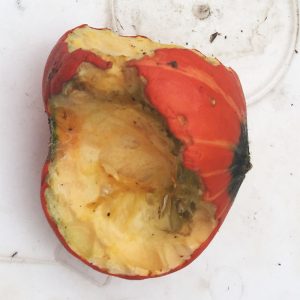 Vicki Jordan: What is eating my pumpkins (see picture right)? Is it birds, rats, rabbits or something else? One day they are fine and the next time I look they are eaten. The smaller ones are not on the ground but on a trellis around 1 metre high. The large ones are on the ground and just have bits taken out of them. Vicki Jordan: What is eating my pumpkins (see picture right)? Is it birds, rats, rabbits or something else? One day they are fine and the next time I look they are eaten. The smaller ones are not on the ground but on a trellis around 1 metre high. The large ones are on the ground and just have bits taken out of them. |
Rats, mice, brushtail possums, deer, kangaroos, wallabies or wombats? Robin Gale-Baker: Rats. I once saw a half acre full of beautiful pumpkins devastated by rats overnight. Hundreds of them devoured! I picked 3 pumpkins high up in our feijoa tree before the stem withered as, the moment they ripen, the rats go for them. Pam Jenkins: Rats. They don’t mind climbing a trellis. Unlikely to be possums as they don’t like being on the ground. I’ve never heard of rabbits eating undamaged pumpkin – I hope they don’t! Joanne Driver: Rats. I have had the same trouble this year with tomatoes and some apples. Our cat has a daily home on the compost pile near the bins and we have seen a few results. Kris Filmer: Rats. We have had the same problem, as well as our potatoes being eaten underground. Peter Bevz: Rats or mice, almost certainly. I’ve had identical issues in the past. Nowadays, when my pumpkins are ripening, I check them every day and, at the first sign of any nibbling, I harvest them all. Marsha Merory: Brushtail possum. I lost 5 pumpkins (2 golden nuggets and 3 jap pumpkins) to a large brushtail possum. I then put metal waste paper bins on my last 3 pumpkins, with 2 bricks on top of each – so far, so good. Angelo Eliades (before seeing Duang’s response below): Rats or possums, as rabbits aren’t capable of eating veggies hanging 1 metre off the ground, and birds wouldn’t eat that much and would leave tell-tale pointed pecking marks. The simple way to tell if it’s rats or possums is to net the pumpkins: if possums are the culprit then the pumpkins will be protected by the netting, but if rats are the problem then they will chew through the netting and eat the pumpkins! Duang Tengtrirat: Deer. When we lived in Research, our pumpkins were eaten and the carcass looked just like the one in the photo. We first blamed the kangaroos then the rabbits, both of which there were plenty. After installing a camera, however, it became clear that the culprit was actually deer (a big deer with antlers). Angelo (after seeing Duang’s response): Kangaroos and wallabies, maybe. If you live somewhere rural, then kangaroos and wallabies, as well as deer, would also be possibles. But, unlike rodents, none of these animals would chew through netting. And Angelo again: Wombats, maybe. At Bulleen Art & Garden nursery (BAAG), we once caught a wombat on our security cameras eating the blueberries in the driveway! |
| 13. Sandie Downes: I have two olive trees, variety unknown. Lots of the olives are falling off. They are small and green. Any suggestions about how to use them? | Morgan Koegel: You can either preserve them (e.g. through brining) or press them into oil. For pressing, you only receive back about 10% as oil (the pip and pulp are discarded) so you need quite a lot of olives to justify undertaking this adventure. |
12. 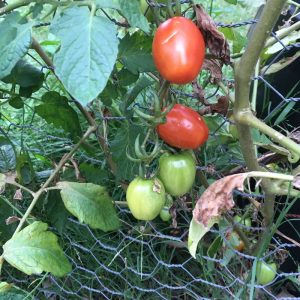 Carol Woolcock: A feral tomato that has popped up in my garden. I first thought that it came from the compost but I have never bought or grown one that looks like this. It is fleshy and sweet with few seeds. Should I save some seeds to grow next season? Is it a named variety? Carol Woolcock: A feral tomato that has popped up in my garden. I first thought that it came from the compost but I have never bought or grown one that looks like this. It is fleshy and sweet with few seeds. Should I save some seeds to grow next season? Is it a named variety? |
Vanessa Reynolds: It looks to me very much like one of the egg-shaped Italian types, such as Roma or San Marzano, both of which are good for passata or canning. |
| 11. Richard Lee, from KABUU: I would like to learn about vegetables indigenous to the African continent. I’m thinking about plants we could potentially grow in Melbourne as a food crop. Having a greater diversity of species would increase food security. Which African crops could we grow in Melbourne? | Heather: Okra has been planted by an African resident at a community garden I work at in Burwood and is doing very well. [Editor: also see this Facebook post about Ajak, an okra farmer in Coburg.] Also, teff is a grain used to make artisan bakery foods, including Injera, a traditional bread in the Horn of Africa. |
| 10. Kerryn Johnson: My son brought home a mango from a property in Brunswick that he was working at a few weeks ago. The mango had been grown in their backyard! It was a lot smaller than your average mango, with a much smaller pip/seed. As any good gardener would do, I’ve saved the seed. How should I propagate this seed and can one grow mangoes without too much work in Melbourne or am I wasting my time? |
Guy Palmer: If it is the fruit that you are after, I think you would be wasting your time but, as an experiment, I think it could be quite interesting. I have both avocado trees and banana plants. With quite a lot of effort on my part (e.g. shade cloth in both Winter and Summer), these plants now thrive, and they even have baby fruit, but the fruit never mature and ripen. My understanding is that mangoes are even more difficult to achieve success with in Melbourne. However, they are included as a possible in Louis Glowinski’s book. Angelo Eliades points out another problem: the mango seed is likely to be fertilised and thus its DNA will be a combination of both of its parents rather than a clone of its mother. So, for example, just because the mother plant is hardy enough to survive in Melbourne doesn’t mean that the seed will be. More generally, it is because most fruit trees don’t grow true to seed that they are usually propagated by grafting or cutting rather than by seed. Putting this another way, if you plant a seed from a Granny Smith apple, you might well get an apple tree but it certainly won’t be a Granny Smith apple tree. And, indeed, all the Granny Smith apple trees throughout the world have originated by grafting or cutting from a single chance Australian seedling from 1868. Finally, Angelo points out that, if Keryn decides to plant the seed, she can find mango seed planting instructions on The Western Australian Government website. |
| 9. Tracey Bjorksten: Most planting guides say that you should plant Brussels sprouts at the same time as other brassicas (i.e. around now) but that sounds suspiciously late to me. For those of you who have grown Brussels sprouts successfully, when did you start their seed and when did you transplant out? |
Angelo Eliades: In my opinion, February is the month to plant, with the harvest time of 14-28 weeks that will mean harvest in mid-June to September before it gets too hot. Bruno Tigani: There is a large Brussels sprouts grower in Coldstream. Their transplanting season runs from November to February, growing different varieties all the way through and harvesting from March to September. Guy Palmer: The farm that Bruno is referring to is called Adams Farms. I spoke with the farmer there, Jeremy Adams, and he confirmed Bruno’s timetable, which means that their seeds are planted from September to end December. I asked Jeremy when home growers in North East Melbourne should plant their seeds and he said that it all depended on the variety. For example, whilst Gustus is a cool season variety which should be planted in late December, Gladius is effectively a warm season variety which they plant in September. He said that people could ring him in November on 0433 396 444 and get some seedlings from him. Thanks, Jeremy! |
| 8. Louise Nolan: I heard somewhere that you can freeze herbs in oil? Chop up the herbs, place in ice cube trays, fill with olive oil and then place in the freezer. When wanting to use place the oil cube into your cooking. Has anyone tried this? Any problems with this method? |
Meera Govil: According to Jamie Oliver’s website, wash the herbs gently, dry on kitchen towel, chop finely before packing them tight in ice cube trays and covering with water before freezing. Delicate herbs like coriander, chives, dill are good for this method. More robust herbs, like rosemary, oregano, mint, lemon verbena, are better dried. My mum cuts the herbs on a coolish day, washes and dries them on a cloth kitchen towel for about 1 hour before snipping off the thicker stems and laying the herbs out in a single layer on a sheet of newspaper in semi sun. She brings them in every evening for 3 days before grinding them in a little spice grinder and then putting them into small glass bottles for her (grown up) grandchildren. Samantha Patterson: I have tried this and continue to practice it, finding it has its place among other ways to preserve excess herbs. However, one must be aware of its limitations. The freezing process does bruise the herbs (especially softer ones like basil), and one must be careful with ‘when’ in the cooking process the oil-herb cube is added – if added at the start, the herbs can over cook and the flavour is quite different. I successfully use oil-herb cubes in soups and casseroles, or used as a ‘rub’ on toasted bread for bruschetta. It also works well for a quick light ‘stir fry’ of leafy greens like kale. And I also use this oil freezing process with crushed garlic. |
| 7. Sue Doman: I have picked my sweetcorn too early. Will it continue to ripen? | Guy Palmer: no, sweetcorn does not ripen after being picked (technically, it is non-climacteric). I judge whether my cobs are ripe by breaking a kernel with my fingernail and seeing if any milky substance oozes out – if yes, then it is ripe. |
| 6. Meera Govil: Does anyone know how to dry oregano and mint so that they remain green when dry? |
Robyn Currie: I just gather bunches of oregano, about a half inch in diameter, tie and hang upside down in an out of the way place in the kitchen (usually a cupboard doorknob). After a couple of weeks or more, the leaves are dry and a dark green. |
| 5. Ann Stanley: Are micro-greens grown from special seeds or are they just densely planted and therefore stunted shoots of normal seeds? | Bruno Tigani: the seeds used for micro-green production are generally the same varieties that are used to grow full sized plants. They are sown at higher density and harvested at an early stage, often with just the cotyledon leaves. |
| 4. Ann Stanley: Are micro-greens more nutritious than ‘macro’ greens and, if so, why? | Bruno Tigani: according to this research paper, the nutrient density in micro-green cotyledon leaves are likely higher than those of a mature plant. Among the 25 commercially available microgreens tested, red cabbage, coriander, garnet amaranth, and green daikon radish had the highest concentrations of ascorbic acids, carotenoids, phylloquinone, and tocopherols, respectively. However, as Bruno observes, you might eat 100gm of broccoli at a mature size compared to 10gm as micro-greens, so the absolute amount of nutrition is probably higher from eating mature broccoli. |
| 3. Susie Scoullar: How does one make black garlic and where can it be bought locally? | Chris Newman: per Wikipedia, black garlic is made by heating whole bulbs of garlic over the course of several weeks and the taste is sweet and syrupy. You can buy it on ebay but it is very expensive (around $160 per Kg) and I am going to try making using a black garlic fermenter, which is available on ebay for around $100. Apparently, you just choose the fermenting mode and put the garlic in for up to 12 days and then afterwards let it dry for 5 days. |
| 2. Amanda Gutierrez: Does anyone know about any classes or workshops on maintaining goats? |
Pauline Webb: Sylvia Allen, wife of Pete the Permie, knows all about goats. I’ve spoken to Pete and he agrees with Pauline and said that people are more than welcome to ring Sylvia and himself to ask their questions. Phone number: 0418 665880. Fay Loveland: PIP magazine has published a podcast interview with Maria Cameron about keeping goats in a shared backyard context. Maria is from Hibi Farm in Heidelberg West, where she shares some goats with some of her neighbours. |
| 1. Vicki Jordan: Are there any facilities for recycling corks? |
Julie Cabrol: Darebin Council has made the following bald statement: “there is currently no recycling option for corks in Australia.” According to the Ecobin website, this is because corks are not virgin cork and contain other resins. Lucinda Flynn: whilst they no longer get collected for the zoos, they are fine to put into the compost. |

